GemTek Technology A930909G Dell Wireless 4350 Small Network Access Point User Manual Part 1
Gemtek Technology Co., Ltd. Dell Wireless 4350 Small Network Access Point Users Manual Part 1
Contents
- 1. Users Manual Part 1
- 2. Users Manual Part 2
Users Manual Part 1

Technical Specifications and Regulatory Information:
Dell™ Wireless 4350 Small Network Access Point
User's Guide
Technical Specifications
Regulatory Information
Limited Warranties and Return Policy
Wireless Interoperability
The Dell Wireless 4350 Small Network Access Point products are designed to be
interoperable with any wireless LAN product that is based on direct sequence spread
spectrum (DSSS) and orthogonal frequency division multiplexing (OFDM) radio technology
and to comply with the following standards:
• IEEE 802.11b Standard on Wireless LAN
• IEEE 802.11g Standard on Wireless LAN
• Wireless Fidelity (WiFi) certification, as defined by the WECA (Wireless Ethernet
Compatibility Alliance)
Wireless 802.11 and Your Health
The Dell Wireless 4350 Small Network Access Point, like other radio devices, emits radio
frequency electromagnetic energy. The level of energy emitted by this device, however, is less
than the electromagnetic energy emitted by other wireless devices such as mobile phones.
The Dell Wireless 4350 Small Network Access Point device operates within the guidelines
found in radio frequency safety standards and recommendations. These standards and
recommendations reflect the consensus of the scientific community and result from
deliberations of panels and committees of scientists who continually review and interpret the
extensive research literature. In some situations or environments, the use of the DDell
Wireless 4350 Small Network Access Point devices may be restricted by the proprietor of the
building or responsible representatives of the applicable organization. Examples of such
situations include the following:

• Using the Dell Wireless 4350 Small Network Access Point equipment on board
airplanes, or
• Using the Dell Wireless 4350 Small Network Access Point equipment in any other
environment where the risk of interference with other devices or services is perceived
or identified as being harmful.
If you are uncertain of the policy that applies to the use of wireless devices in a specific
organization or environment (an airport, for example), you are encouraged to ask for
authorization to use the Dell Wireless 4350 Small Network Access Point device before you
turn it on.
Technical Specifications
Standards supported IEEE 802.3, IEEE 802.3u, IEEE802.11b, 802.11g
Protocols TCP/ IP, IPX, UDP, DHCP Client, DHCP Proxy
Environment • Operating Humidity 10% to 85% (Non-Condensing)
• Storage Humidity 5% to 90% (Non-Condensing)
• Operating Temperature 0° to 40° C (32° F to 104° F)
• Storage Temperature 0° to 70° C (32° F to 158° F)
Power specification Receive Sensitivity
• 11Mbps: 10-5 BER @ -80 dBm, typical
• 54Mbps: 10-5 BER @ -65 dBm, typical
Transmit Power
• Normal Temp Range: ±12 dBm
DC power supply
• Input: AC 100-250 50-60 Hz 1A
• Output: 5V DC 2A
• Power over Ethernet

Radio specification
Range: "Up to 100m" indoors and "Up to 450m" outdoors (open
range)
Frequency range: 2.4 - 2.4835 GHz, direct sequence spread
spectrum
Number of Channels:
• Europe: 13 (1-13)
• US: 11 (1-11 )
• France: 2 (10-11 )
• Japan: 11 (1-13 )
• Taiwan: 11 (1-11)
Mobility: Seamless roaming across cell boundaries with
handover
Specific features
Supported bit rates:
For 802.11g:
• 54 Mbps
• 48 Mbps
• 36 Mbps
• 24 Mbps
• 18 Mbps
• 12 Mbps
• 9 Mbps
• 6 Mbps
For 802.11b:

• 11 Mbps
• 5.5 Mbps
• 2 Mbps
• 1 Mbps
Data Encryption: WEP (64/128 bit) and WPA
Utility Software • Setup Wizard software
• Control Utility software
Regulatory Information
The Dell Wireless 4350 Small Network Access Point device must be installed and used in strict
accordance with the manufacturer's instructions as described in the user documentation that
comes with the product. For country-specific approvals, see Radio approvals. Dell Inc is not
responsible for any radio or television interference caused by unauthorized modification of the
devices included with this Dell Wireless 4350 Small Network Access Point kit, or the
substitution or attachment of connecting cables and equipment other than that specified by
Dell Inc. The correction of interference caused by such unauthorized modification, substitution
or attachment is the responsibility of the user. Dell Inc and its authorized resellers or
distributors are not liable for any damage or violation of government regulations that may arise
from the user failing to comply with these guidelines.
For the latest regulatory information, documentation, and other updates, please visit the Dell
website at support.dell.com.
Canada -- Industry Canada (IC)
This device complies with RSS210 of Industry Canada.
Canada (IC):
The device is certified to the requirements of RSS-210 for 2.4 GHz spread spectrum devices.
To prevent radio interference to the licensed service, this device is intended to be operated
indoors and away from windows to provide maximum shielding.
This device has been designed to operate with an antenna having a maximum gain of 2.0 dBi.
Antenna having a higher gain is strictly prohibited per regulations of Industry Canada. The

required antenna impedance is 50 ohms.
To reduce potential radio interference to other users, the antenna type and its gain should be
so chosen that the EIRP is not more than required for successful communication.
Europe -- EU Declaration of Conformity
This equipment complies with the essential requirements of the European Union directive
1999/5/EC.
Cet équipement est conforme aux principales caractéristiques définies dans la Directive
européenne RTTE 1999/5/CE.
Die Geräte erfüllen die grundlegenden Anforderungen der RTTE-Richtlinie 1999/5/EG.
Questa apparecchiatura è conforme ai requisiti essenziali della Direttiva Europea R&TTE
1999/5/CE.
Este equipo cumple los requisitos principales de la Directiva 1999/5/CE de la UE, "Equipos de
Terminales de Radio y Telecomunicaciones".
Este equipamento cumpre os requisitos essenciais da Directiva 1999/5/CE do Parlamento
Europeu e do Conselho (Directiva RTT).
Deze apparatuur voldoet aan de noodzakelijke vereisten van EU-richtlijn betreffende
radioapparatuur en telecommunicatie-eindapparatuur 1999/5/EG.
Dette udstyr opfylder de Væsentlige krav i EU's direktiv 1999/5/EC om Radio- og
teleterminaludstyr.
Dette utstyret er i overensstemmelse med hovedkravene i R&TTE-direktivet (1999/5/EC) fra
EU.
Utrustningen uppfyller kraven för EU-direktivet 1999/5/EC om ansluten teleutrustning och
ömsesidigt erkännande av utrustningens överensstämmelse (R&TTE).
Tämä laite vastaa EU:n radio- ja telepäätelaitedirektiivin (EU R&TTE Directive 1999/5/EC)
vaatimuksia.
France
Some areas of France have a restricted frequency band. The worst-case maximum authorized
power indoors is:
10 mW for the entire 2.4 GHz band (2400 MHz - 2483.5 MHz)
100 mW for frequencies between 2446.5 MHz and 2483.5 MHz (NOTE - Channels 10 through
13 inclusive operate in the band 2446.6 MHz - 2483.5 MHz)
There are few possibilities for outdoor use: On private property or on the private property of
public persons, use is subject to a preliminary authorization procedure by the Ministry of
Defence, with maximum authorized power of 100 mW in the 2446.5 - 2483.5 MHz band. Use
outdoors on public property is not permitted.
In the departments listed below, for the entire 2.4 GHz band:
Maximum authorized power indoors is 100 mW
Maximum authorized power outdoors is 10 mW
Departements in which the use of the 2400 - 2483.5 MHz band is permitted with an EIRP of
less than 100 mW indoors and less than 10 mW outdoors:
01 Ain
Orientales 36 Indre 66 Pyrénées
02 Aisne 37 Indre et Loire 67 Bas Rhin
03 Allier 41 Loir et Cher 68 Haut Rhin
05 Hautes Alpes 42 Loire 70 Haute Saône
08 Ardennes 45 Loiret 71 Saône et
Loire
09 Ariège 50 Manche 75 Paris
11 Aude 55 Meuse 82 Tarn et
Garonne
12 Aveyron 58 Nièvre 84 Vaucluse
16 Charente 59 Nord 88 Vosges
24 Dordogne 60 Oise 89 Yonne
25 Doubs 61 Orne 90 Territoire de
Belfort
26 Drôme 63 Puy du Dôme 94 Val de Marne
32 Gers 64 Pyrénées
Atlantique

This requirement is likely to change over time, allowing you to use your wireless LAN card in
more areas within France. Please check with ART for the latest information
(www.art-telecom.fr)
NOTE: Your Dell Wireless 4350 Small Network Access Point transmits less than 100 mW,
but more than 10 mW.
Italia
A license is required for indoor use. Outdoor use is prohibited.
E' necessaria la concessione ministeriale anche per l'uso interno. Verificare con i rivenditori la
procedura da seguire. L'uso per installazione in esterni non e' permessa.
USA -- Federal Communications Commission (FCC)
This device complies with Part 15 of the FCC Rules. Operation of the device is subject to the
following two conditions:
This device may not cause harmful interference.
This device must accept any interference that may cause undesired operation.
Dell declares that WAPA-118GD ( FCC ID: MXF-A930909G ) is limited in CH1~CH11 for
2.4GHz by specified firmware controlled in U.S.A.
Interference statement
This equipment has been tested and found to comply with the limits for a Class B digital device,
pursuant to Part 15 of the FCC Rules. These limits are designed to provide reasonable
protection against harmful interference in a residential installation. This equipment generates,
uses, and can radiate radio frequency energy. If the equipment is not installed and used in
accordance with the instructions, the equipment may cause harmful interference to radio
communications. There is no guarantee, however, that such interference will not occur in a
particular installation. If this equipment does cause harmful interference to radio or television
reception (which can be determined by turning the equipment off and on), the user is
encouraged to try to correct the interference by taking one or more of the following measures:
Reorient or relocate the receiving antenna.
Increase the distance between the equipment and the receiver.
Connect the equipment to an outlet on a circuit different from that to which the receiver is

connected.
Consult the dealer or an experienced radio/TV technician for help.
NOTE: This Dell Wireless 4350 Small Network Access Point device must be installed and
used in strict accordance with the manufacturer's instructions as described in the
user documentation that comes with the product. Any other installation or use will
violate FCC Part 15 regulations.
IMPORTANT NOTE
FCC RF Radiation Exposure Statement
This equipment complies with FCC RF radiation exposure limits set forth for an uncontrolled
environment. This equipment should be installed and operated with a minimum distance of 20
centimeters between the radiator and your body. This transmitter must not be co-located or
operating in conjunction with any other antenna or transmitter.
Radio approvals
To determine whether you are allowed to use your wireless network device in a specific
country, please check to see if the radio type number that is printed on the identification label
of your device is listed on the radio approval list posted on the general Dell support site at
support.dell.com.
Introduction:
Overview
Wireless Networking Overview
A Look at the Hardware
Overview
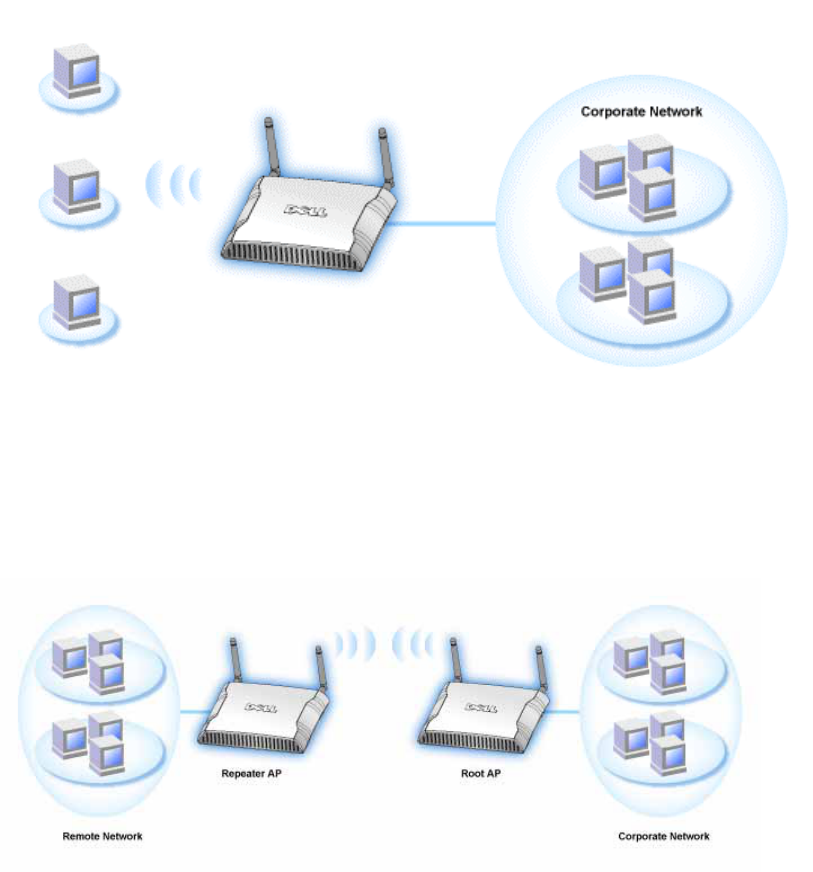
The Dell Wireless 4350 Small Network Access Point is an 802.11b/g wireless access point that
allows wireless clients access to a corporate network. The Access Point can be configured in
the following ways:
• Wireless hub (Access Point): In this mode the Access Point connects wireless
computers to the corporate network.
• Wireless repeater: In this mode the Access Point is able to extend the wireless range
of a root Access Point that is on the corporate network to remote wireless computers.
The Dell Wireless 4350 Small Network Access Point supports up to 64 wireless clients. It runs
at speeds up to 54 Megabits per second (Mbps), and the LAN (wired) port runs at 10/100
Mbps. The maximum distance between the Access Point and each Wireless computer is 300
feet. This distance may be less depending on your environment.

By default, the Dell Wireless 4350 Small Network Access Point provides the following
functionality:
• a wireless access point using wireless as the wireless network name.
• a bridge to an Ethernet hub.
Wireless Networking Overview:
Wireless Local Area Network (WLAN)
Identifying a WLAN
Encryption
Automatic Rate Selection and Rate Scaling
Wireless Local Area Network (WLAN)
A Local Area Network (LAN) is a network in one location. Users at that location can share files,
printers, and other services. In a LAN, a networked computer that requests services is called a
client. A Wireless Local Area Network (WLAN) is a type of LAN that uses high frequency
radio waves rather than wires to communicate and transmit data among the network clients and
devices. It is a flexible data communication system implemented as an extension to, or as an
alternative for, a wired LAN.
In a WLAN, wireless adapters are installed in clients, also called wireless clients. The adapter
allows the wireless client to communicate with the WLAN without cables. Instead, wireless
clients send and receive information through a path in the air called a channel.
The standards for a WLAN are based on the IEEE 802.11b standard and IEEE 802.11g
standard. All Dell 802.11b/g-compliant devices interoperate with other 802.11b/g -compliant
wireless devices from other vendors. The WiFi certification logo indicates that the wireless
device has been tested by an independent organization.
A wireless client operates in either infrastructure mode or peer-to-peer mode.

Identifying a WLAN
An ESSID and BSSID are both Service Set Identifiers (SSID) that identify and control the
wireless client’s access to a given WLAN. The SSID is sometimes referred to as the network
name. The SSID indicates what WLAN you are referring to. In most cases, the user interface
displays the SSID.
When installing an access point or wireless adapter in a wireless client, the installation program
asks you to enter the SSID. Dell cannot provide you with this information, as it is specific to your
network; but you may choose to use the default SSID, wireless, for your Dell Wireless 4350
Small Network Access Point. All wireless clients and access points in a WLAN must use the
same network name.
Encryption
In a WLAN, wireless clients and access points send and receive information through the air.
Without implementing security, it is possible for an unauthorized person to intercept the
information.
A common way of implementing security and protecting information is encryption. Encryption
applies a set of instructions, called an algorithm, to information. The instructions combine the
plain or clear text of information with a sequence of hexadecimal numbers, called an encryption
key.
Before transmitting information over the airwaves, the wireless client or access point encrypts
or scrambles the information. The access point or wireless client receiving the information uses
the same key to decrypt or unscramble the information. The information is only readable to
WLAN devices that have the correct encryption key. The longer the key is, the stronger the
encryption.
The Dell Wireless 4350 Small Network Access Point supports both Wired Equivalent Privacy
(WEP) and Wi-Fi Protected Access (WPA).
WEP
WEP (Wired Equivalent Privacy) provides a way of creating an encrypted key that is shared
between a wireless client (such as a notebook with a wireless PC card) and the router. In the
Dell Wireless 4350 Small Network Access Point, WEP is an optional feature that can be
enabled or disabled. When WEP encryption is enabled, you must set the WEP key in the client

to match the WEP key used by the access point because you can ONLY connect to access
points that have a matching WEP Key. The Dell Wireless 4350 Small Network Access Point
Setup Wizard allows the user to gracefully configure WEP encryption on both the access point
and wireless clients.
NOTE: It is better to change keys frequently. The same algorithm is used for all the
communications that should be protected. If the same key is used, the same
message will give exactly the same cipher text. Then, it will be possible for an
eavesdropper to break the encrypted data. For this reason, it is strongly
recommended to change keys often.
There are two WEP encryption methods:
• 40(64)-bit Encryption
• 104(128)-bit Encryption
40-bit and 64-bit encryption are identical. Some vendors use the term 40-bit; others use 64-bit.
A wireless device that claims to have 40-bit encryption interoperates with a device that claims to
have 64-bit encryption; the same is true for the reverse. A 40(64)-bit key consists of 10
hexadecimal numbers, arrayed as follows:
Key #1: 1011121314
Key #2: 2021222324
Key #3: 3031323334
Key #4: 4041424344
A 104(128)-bit key has several trillion times as many possible combinations than a 40(64)-bit
key. It consists of 26 hexadecimal numbers, arrayed as follows:
Key (#1): 101112131415161718191A1B1C
All wireless clients and access points in a WLAN must use the same encryption method and
key. The following two examples stress how important this point is.
Example 1

The encryption method for an access point is 40(64)-bit. The method for a wireless client is
104(128)-bit encryption. The client and access point cannot communicate with each other,
even though the selected key is the same. To resolve this problem, set the access point to use
104(128)-bit encryption.
Example 2
The encryption method is the same for the access point and wireless client. You select key 1 for
the access point and key 2 for the wireless client. The wireless client cannot communicate with
the WLAN. To resolve this problem, select key 1 for the wireless client.
NOTE: Use the same key and encryption method for the wireless devices in the WLAN.
Otherwise, they cannot communicate with each other.
The Dell Wireless 4350 Small Network Access Point uses either hexadecimal digits or ASCII
characters to create encryption keys. Hexadecimal digits include the numbers 0 to 9 and the
letters A to F. For example, the decimal number 15 is represented as F in the hexadecimal
numbering system.
ASCII is the acronym for the American Standard Code for Information Interchange.
Pronounced ask-ee, ASCII is a code for representing English characters as numbers, with each
letter assigned a number from 0 to 127. For example, the ASCII code for uppercase M is 77.
Most computers use ASCII codes to represent text, which makes it possible to transfer data
from one computer to another.
WPA
WPA (Wi-Fi Protected Access) is an upgrade to the WEP standard for securing your wireless
network. WPA is derived from and will be forward-compatible with the future IEEE 802.11i
standard. It provides improved data encryption and user authentication.
To enhance the level of security, WPA uses Temporal Key Integrity Protocol (TKIP)
encryption to address the vulnerabilities of the static keys used in WEP. TKIP includes four
algorithms: message integrity check (MIC), to protect packets from tampering; Per-Packet
Key (PPK) hashing, to prevent weak key attacks; extended initialization vector (IV), to reduce
IV reuse and the possibility that a hacker will collect sufficient packets to crack the encryption;
and a re-keying mechanism, to change the temporal key dynamically. TKIP is the most
commonly used encryption method; however, if your wireless clients do not support TKIP, the
Wireless 4350 also supports Advanced Encryption Security (AES) encryption. AES will

replace 802.11's RC4-based encryption under the 802.11i specification. AES, the
gold-standard encryption algorithm, provides maximum security for wireless network.
For user authentication, WPA adopts an authentication scheme through 802.1x. 802.1x
provides a framework for user authentication and a key distribution management method.
802.1x consists of three main elements: an Authentication Server (typically a RADIUS server),
WPA-enabled router or AP (called Authenticator), and a WPA-enabled client (called
Supplicant). 802.1x ensures only authorized users can access the network.
In enterprises, WPA will be used in conjunction with both a wireless router and authentication
server. In a Small Office/Home Office (SOHO) environment, where there is no authentication
server, users can use pre-shared key (PSK) mode in place of the authentication server.
The Dell Wireless 4350 Small Network Access Point offers both WPA running in PSK mode and
WPA with 802.1X authentication. The mutual authentication and improved encryption
technology of WPA allows wireless communication to achieve greater security.
Automatic Rate Selection and Rate Scaling
In 802.11g, wireless network adapters and access points can transmit data at one of the
following rates: 54, 48, 36, 24, 18, 12, 9, or 6 Mbps. In 802.11b, the data can be transmitted at
a rate of 11, 5.5, 2, or 1 Mbps. As the distance between an adapter and access point increases
or decreases, the data rate automatically changes. Other factors, like interference, also affect
the data rate. The Dell Wireless 4350 Small Network Access Point uses automatic rate
selection and rate scaling to determine the most efficient rate of communication. Rate scaling
maintains optimal communication between wireless clients and the WLAN.
A Look at the Hardware:
Front Panel
Back Panel
Front Panel
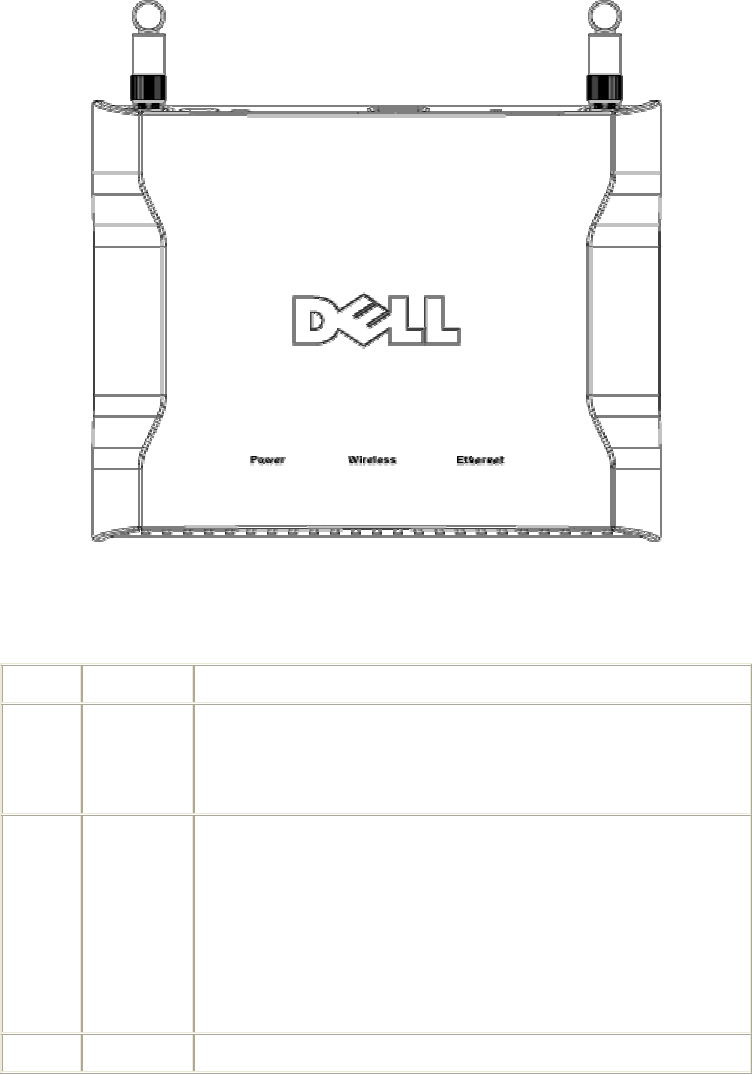
The Dell Wireless 4350 Small Network Access Point has three Light Emitting Diodes (LEDs),
or link lights, on its front side. The following table defines the behaviour for each LED:
Front Panel
LED Represents Activity
Power Power The Power LED will light up green when the device is powered
on and ready for use. It will blink when the device is powering
up or when it is reset
Wireless Wireless
LAN
The LED alternates between on and off when wireless clients
are attached. It will blink when there is data activity on the
wireless network. The rate of blinking will vary with the rate of
data transfer. It turns off when no wireless clients are
associated with the Dell Wireless 4350 Small Network Access
Point.
Ethernet Intranet A steady green light indicates the connection is active, and
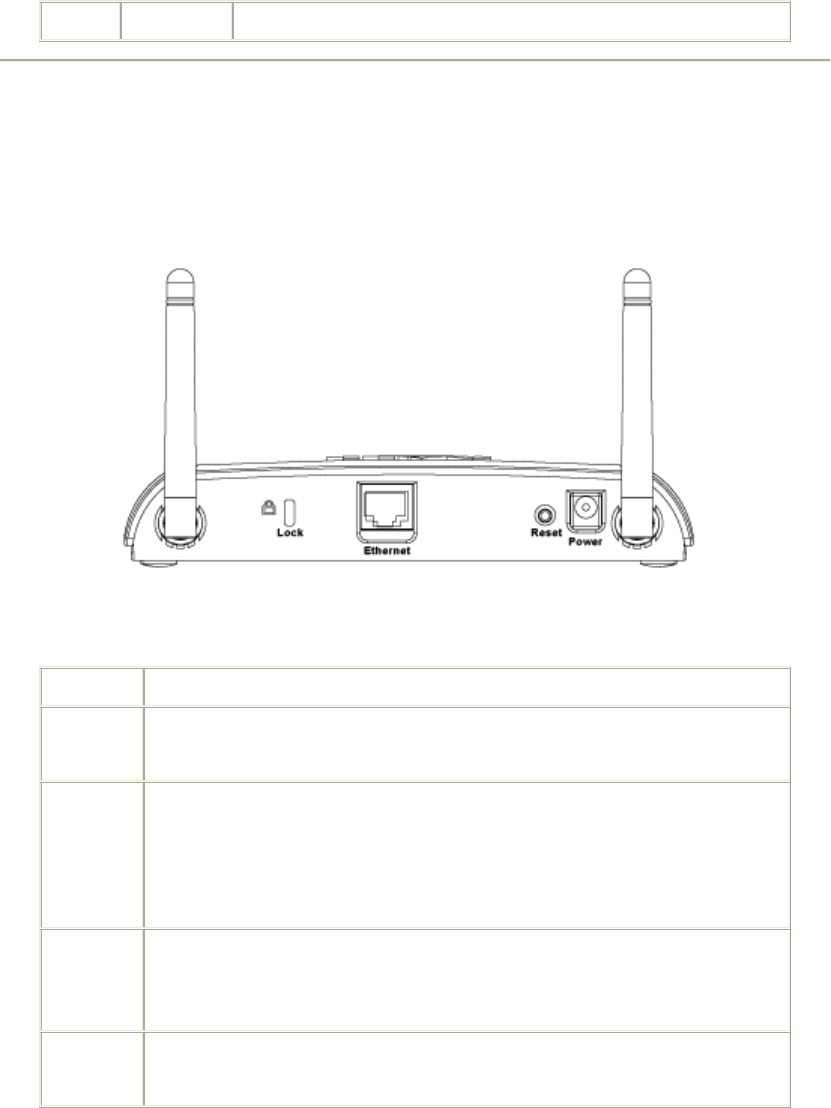
blinks with data activity.
Back Panel
Back Panel
Connector Description
Lock This accepts locking devices for protecting the Dell Wireless 4350 from
theft.
Reset Use an object, such as a paper clip, to press the button for at least 5
seconds. The Power LED will be off for a short time and then light up
again. You can then release the button to reset the device to its
factory-default settings.
Ethernet This accepts an RJ-45 connector for network cabling.
*Also accepts power input from Ethernet port (Power Over Ethernet)
Power Connect the power adapter to this Power port, and then plug the other end
of the power cable into a power outlet.

Using Your Access Point:
Overview
Factory Default Settings
Setup Wizard
Control Utility
Web-Based Configuration Tool
Overview
Factory Default Settings: Your Wireless 4350 Small Network Access Point came with factory
default settings that should work for the majority of the network usage scenarios. However,
there are cases where your network environment may require a different access point
configuration.
Setup Wizard: Setup Wizard is a Windows-based software program included on your Dell
Wireless 4350 Small Network Access Point CD. You can use this program to 1) configure the
access point before connecting it to the network, 2) add wireless clients to the network, 3) install
the Control Utility on your computer and 4) provide links to the user's guide and the Dell support
website.
Control Utility: Control Utility is a Windows-based software program included on your Dell
Wireless 4350 Small Network Access Point CD. This utility can be installed on your computer
by choosing the Install Control Utility option in the Setup Wizard. It provides you with a useful
configuration tool to manage your Dell Wireless 4350 Small Network Access Point. Refer to the
section Control Utility for detailed information.

Web-Based Configuration Tool: The web-based configuration tool is for advanced
configuration of the Dell Wireless 4350 Small Network Access Point. It is a tool provided inside
the access point which can be accessed via the web browser on your computer. This tool
includes every basic and advanced configuration option for the Dell Wireless 4350 Small
Network Access Point. For instance, you can enable multiple virtual AP's or disable your
wireless network.
NOTE: The Setup Wizard and Control Utility must be run on Windows 2000 or Windows
XP computers. Microsoft Internet Explorer 4.0 or higher or Netscape 4.0 or higher
must be used for the web-based configuration tool.
Factory Default Settings:
Dell pre-configures the Dell Wireless 4350 Small Network Access Point with the following
settings:
NOTE: If you lose track of the device settings, you can reset the router by pushing the reset
button to restore these settings back to your router.
Setting Default
User Name admin
Password admin
AP Host Name Dell_4350_AP
IP Address Static IP address of 192.168.2.2
Subnet Mask 255.255.255.0
ESSID (wireless network name) wireless
Channel auto
Encryption No Encryption
Guest Mode Disabled
NOTE: Your Dell Wireless 4350 Small Network Access Point comes with factory default
settings that should work for the majority of the network usage scenarios. However,
there are cases where your network environment may require a different
configuration.
Setup Wizard:
Introduction

Launch the Setup Wizard
Setup Wizard Screens
Introduction
The Setup Wizard is an easy-to-use program included on your Dell Wireless 4350 Small
Network Access Point CD. It provides simplified steps for configuring the Access Point. The
Setup Wizard displays a series of graphical illustrations on how to connect the Access Point to
your computer. It presents the user with the option of changing wireless parameters (such as
SSID, channel number, IP address) and enabling WEP security. Finally it applies these settings
to your access point and validates its configuration. At this point the access point is ready to be
connected to the network. If the configuration cannot be completed successfully, the Setup
Wizard will display troubleshooting instructions to guide you through the configuration process.
In addition, the Setup Wizard also supports the installation of the Control Utility and provides
links to the user's guide on the Dell Wireless 4350 Small Network Access Point CD and the Dell
support website.
Launch the Setup Wizard
To run the Setup Wizard, perform the following steps:
Insert the CD

1. Insert the Dell Wireless 4350 Small Network Access Point CD into the CD drive of a
computer. Your CD should automatically launch the Setup Wizard. If it does not, complete the
following steps to start the Wizard.
a. Click the Start button, and then click Run.
b. Type the following text in the Open: field:
X:\setup.exe
where X is the drive letter of your CD drive.
Once the Setup Wizard has been launched, you will be guided through a series of windows.
These windows are illustrated below along with an explanation on their functionalities.
Setup Wizard Screens
Welcome Menu
This menu offers several options to select from.
• AP Configuration
Begin connecting your access point to the network, it's wireless and security parameters need
to be configured.
• Connect Wireless Computer
Configure wireless computers to connect to the wireless network.
• Install Control Utility
Install the Control Utility on a computer
• User's Guide
View the user's guide (this document)
• Exit
End the Setup Wizard
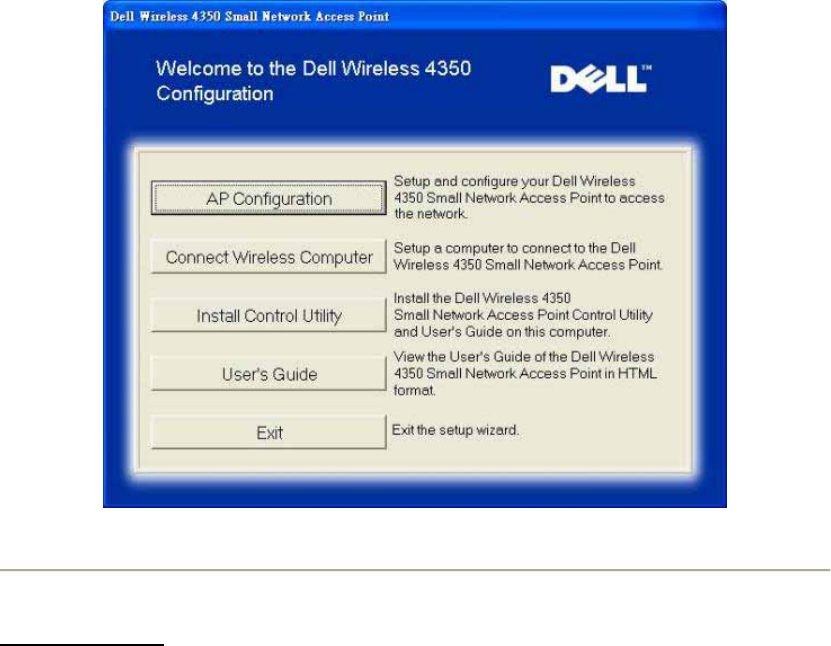
Welcome
AP Configuration
Click AP Configuration if you want to configure the access point before connecting it to the
network and follow the steps described below.
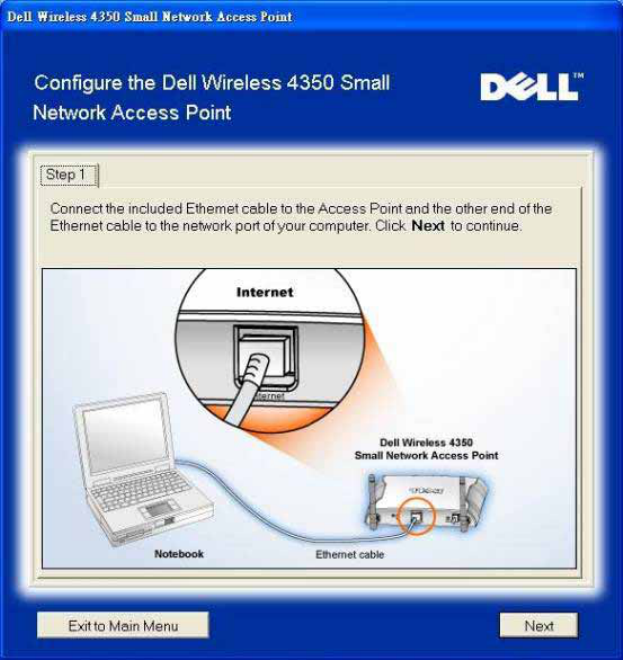
Step 1 illustrates how the computer is to be connected to the Dell Wireless 4350 Small Network
Access Point.
Configure AP: Step 1
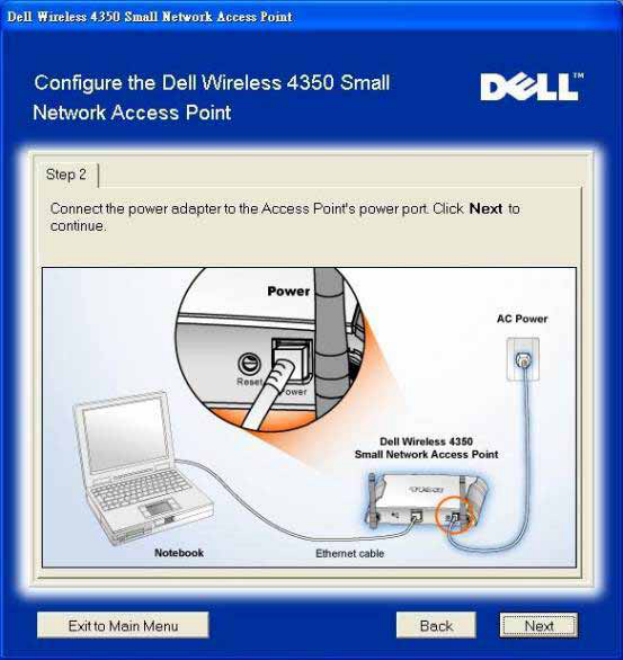
Step 2 illustrates how the Dell Wireless 4350 Small Network Access Point is connected to the
power supply.
Configure AP: Step 2
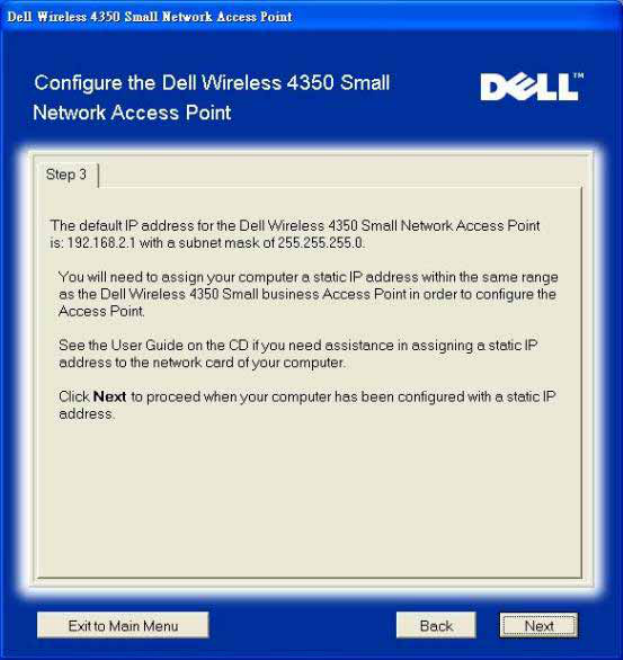
Step 3 informs the user that you need to assign your computer a static IP address within the
same range as the access point. .
Configure AP: Step 3
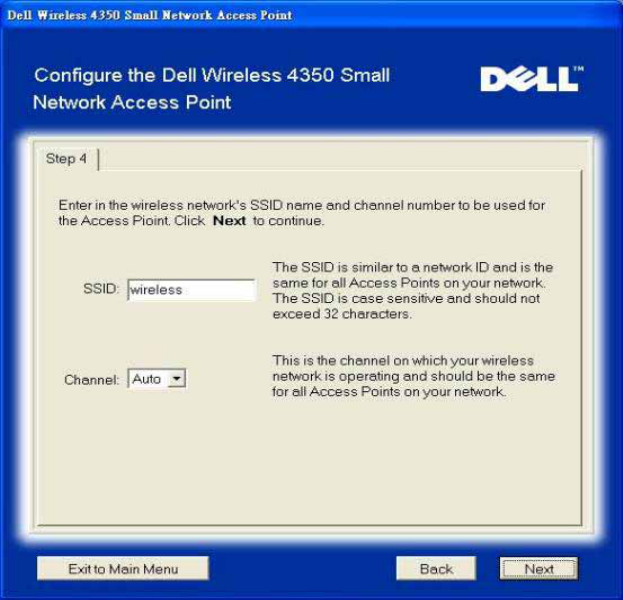
Step 4 gives the user the option to change the wireless network’s SSID and channel number.
Configure AP: Step 4
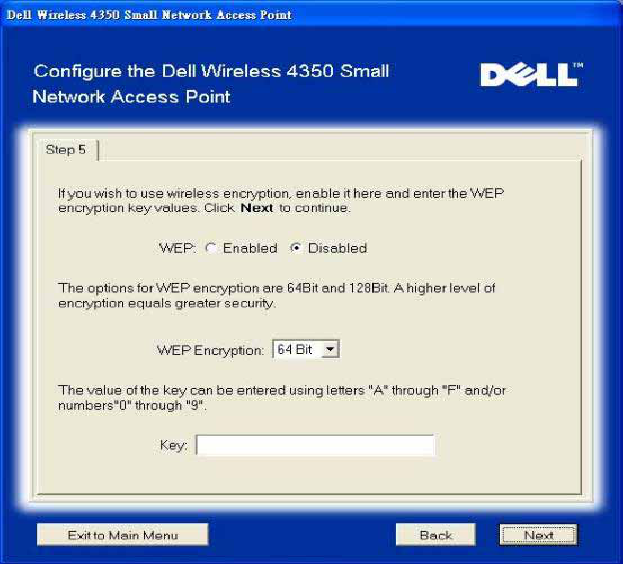
Step 5 gives the user the option to enable WEP wireless encryption and to specify the WEP
encryption key values.
Configure AP: Step 5
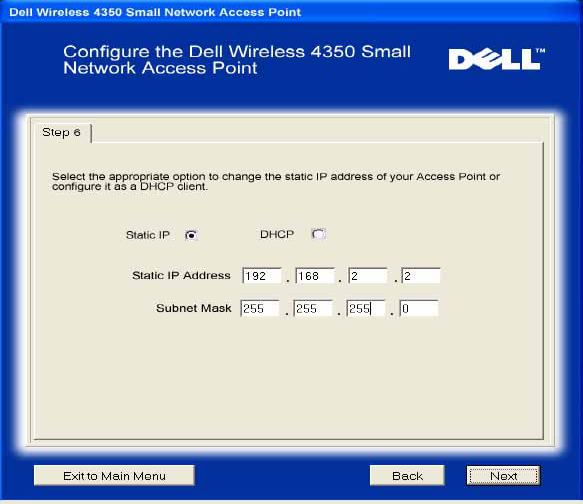
Step 6 gives the user the option to either change the static IP address or set the access point as
a DHCP client.
Configure AP: Step 6
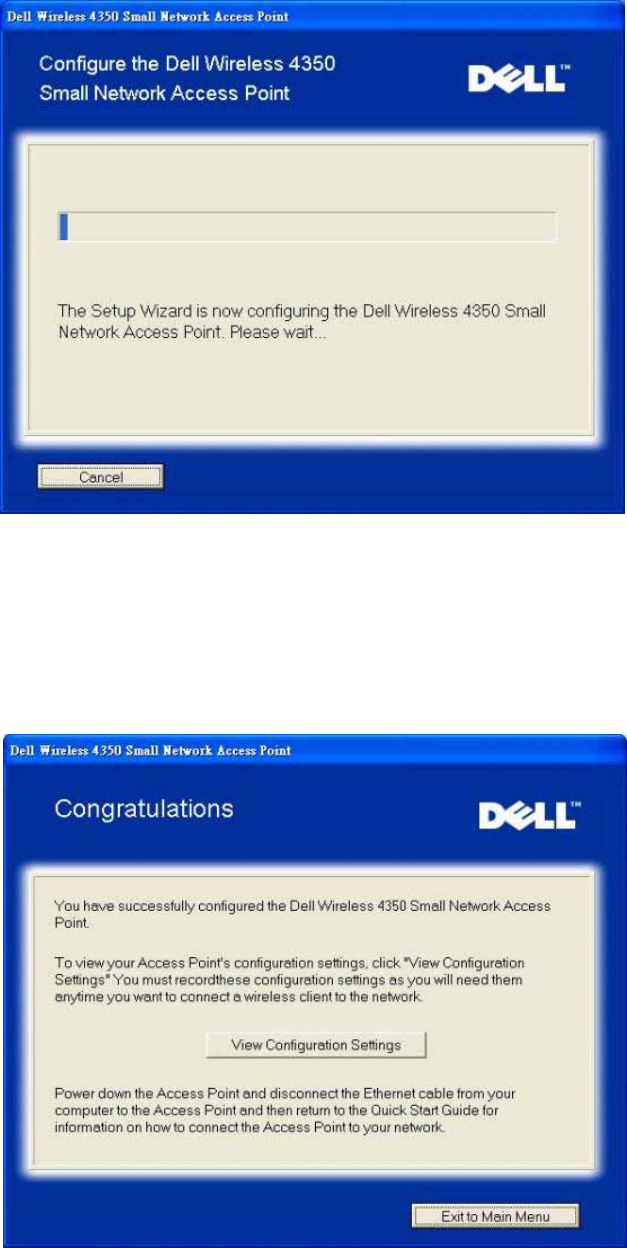
Step 7 informs the user to wait until the Access Point configuration is finished.
Configure AP: Step 7
.
Step 8 is a congratulations screen if the user has successfully configured the Dell Wireless
4350 Small Network Access Point.
Configure AP: Step 8
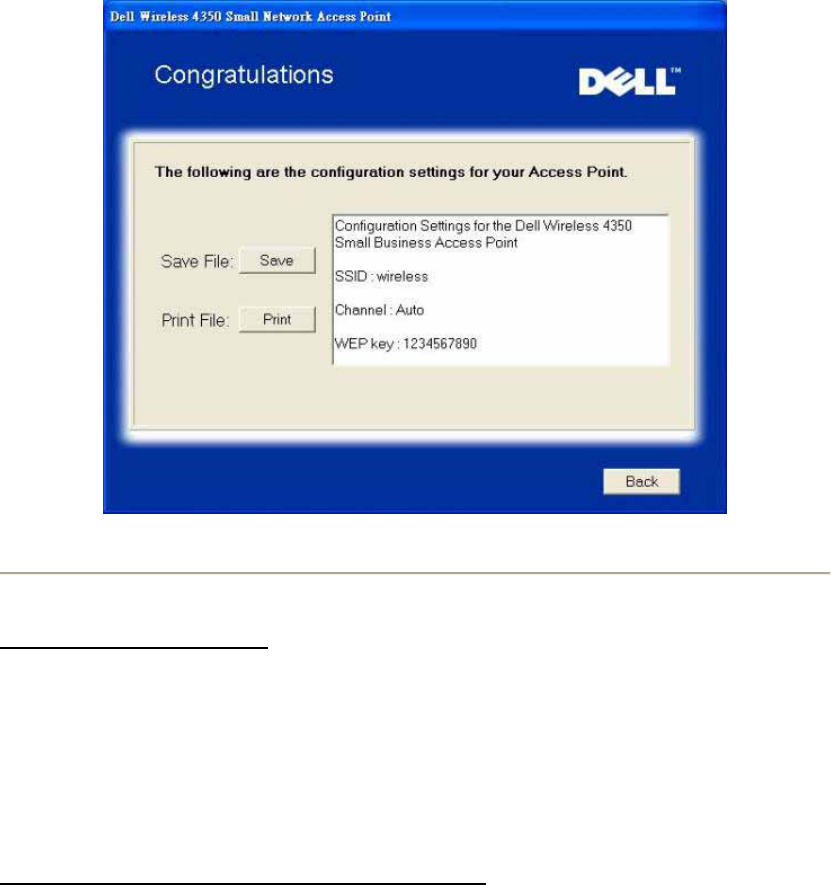
Step 9 is an optional screen that displays the configuration settings chosen by the user.
Configure AP: Step 9
Connect Wireless Computer
To connect computers to your wireless network after you have successfully configured and
installed the Access Point, place the Dell Wireless 4350 Small Network Access Point CD into
each computer and run the Setup Wizard. Click Connect Wireless Computer to add each
wireless computer to your network.
Setup Wireless Computer - Win XP (No Encryption)
Pressing the Setup Wireless Computer button displays instructions to connect computers to
the network through a wireless connection.
Step 1 asks the user to enter the SSID of the wireless network that you wish to connect to.
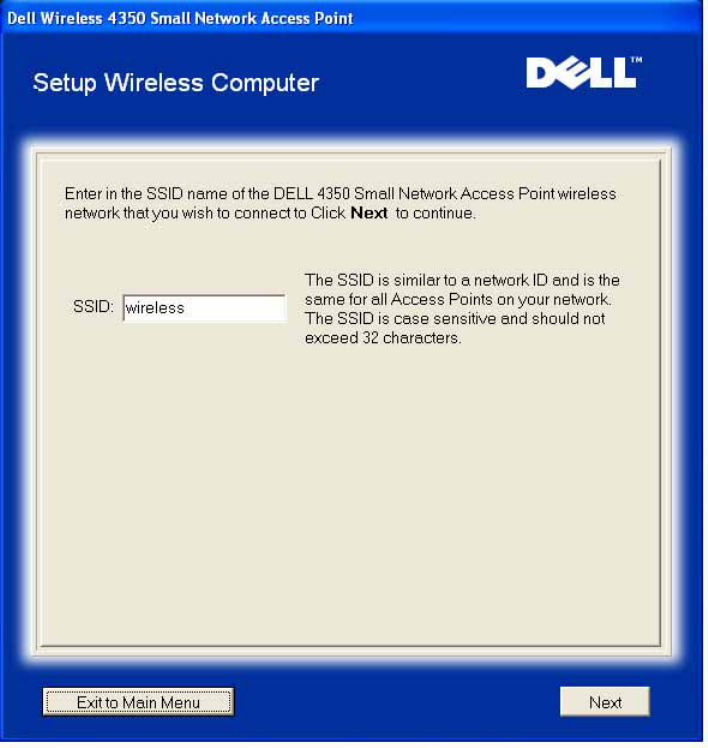
Setup Wireless Computer:
Step 1
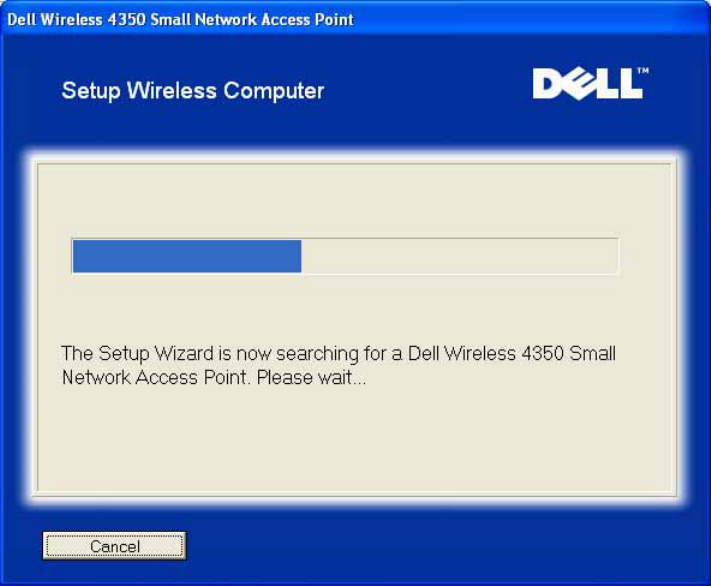
Step 2 asks the user to wait while the Setup Wizard does a site survey scanning for the
requested wireless network.
Setup Wireless Computer:
Step 2
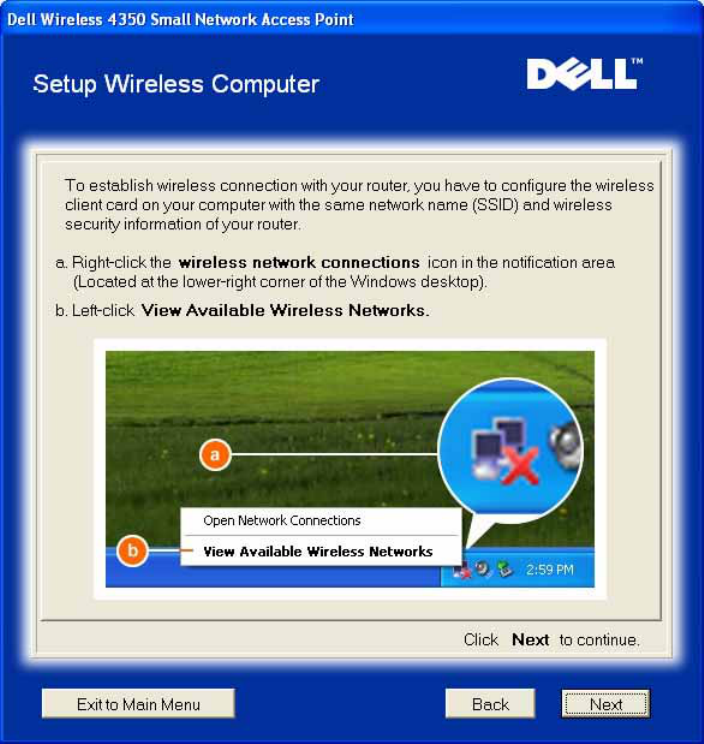
Step 3 guides the user through using the Windows wireless configuration utility to configure the
wireless client.
Setup Wireless Computer:
Step 3
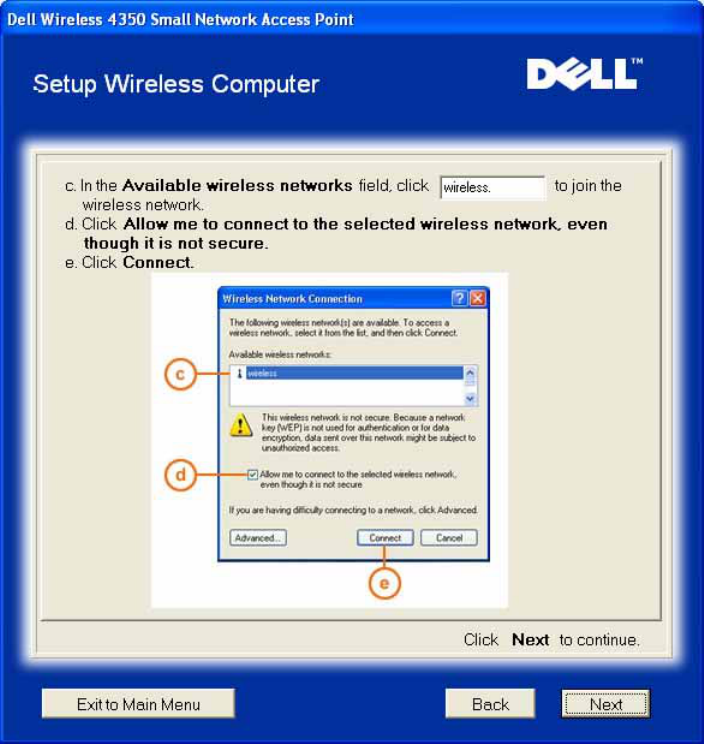
Step 4 guides the user through the remaining steps in using the Windows wireless configuration
utility to configure the wireless client.
Setup Wireless Computer:
Step 4
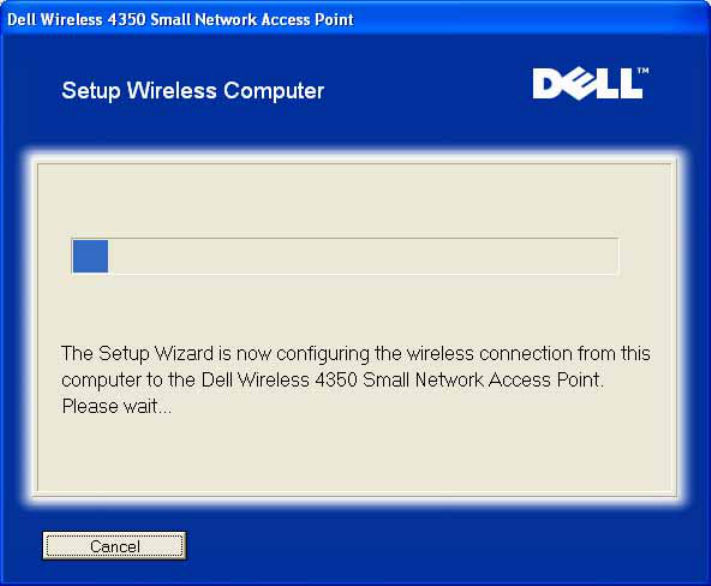
Step 5 informs the user to wait while the wireless client configuration is being verified.
Setup Wireless Computer: Step 5
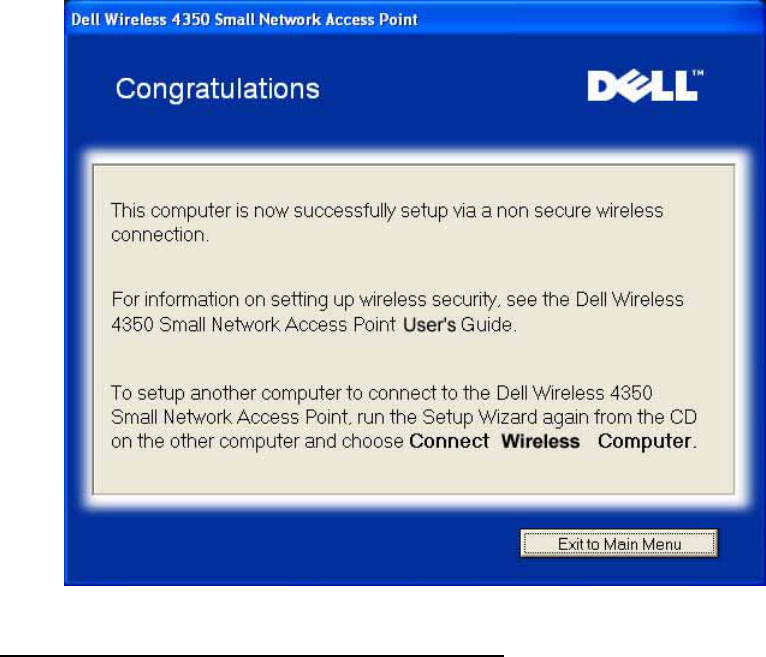
Step 6 informs the user that the wireless client is successfully configured and is now on the
wireless network.
Setup Wireless Computer: Step 6
Setup Wireless Computer - Win XP (WEP Encryption)
Pressing the Setup Wireless Computer button displays instructions to connect computers to
the network through a wireless connection.
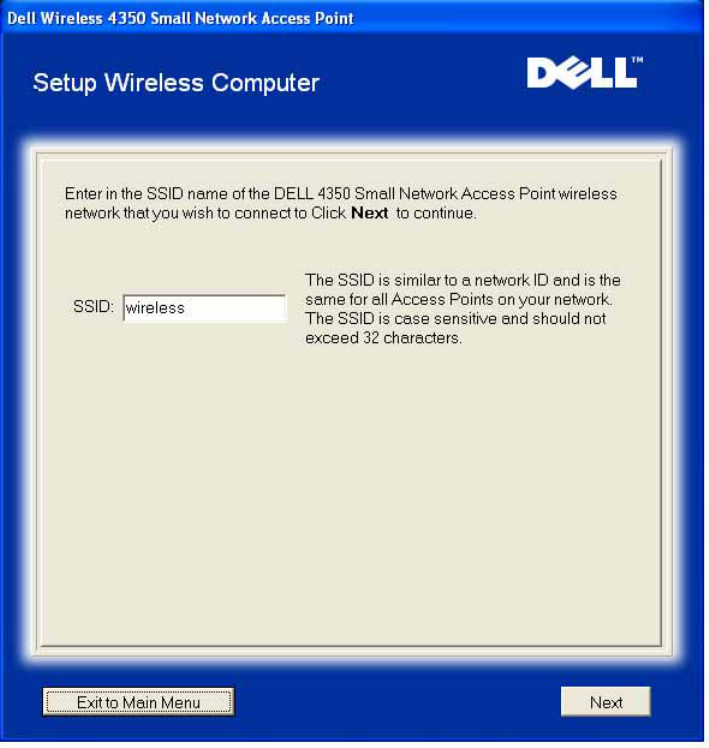
Step 1 asks the user to enter the SSID of the wireless network that you wish to connect to.
Setup Wireless Computer:
Step 1
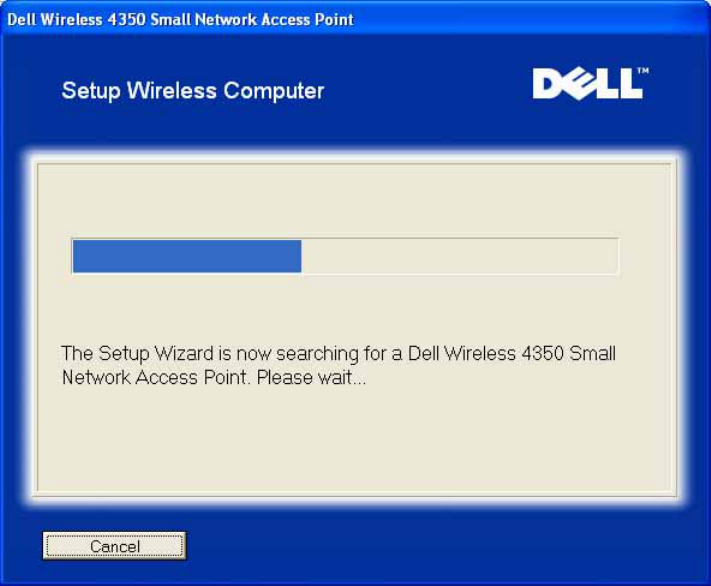
Step 2 asks the user to wait while the Setup Wizard does a site survey scanning for the
requested wireless network.
Setup Wireless Computer:
Step 2
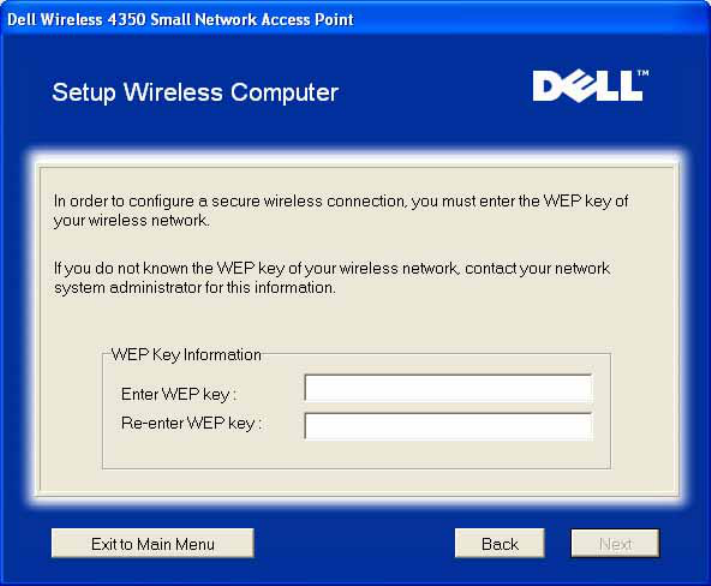
Step 3 asks the user to enter the WEP key of the wireless network that they wish to connect to.
Setup Wireless Computer:
Step 3
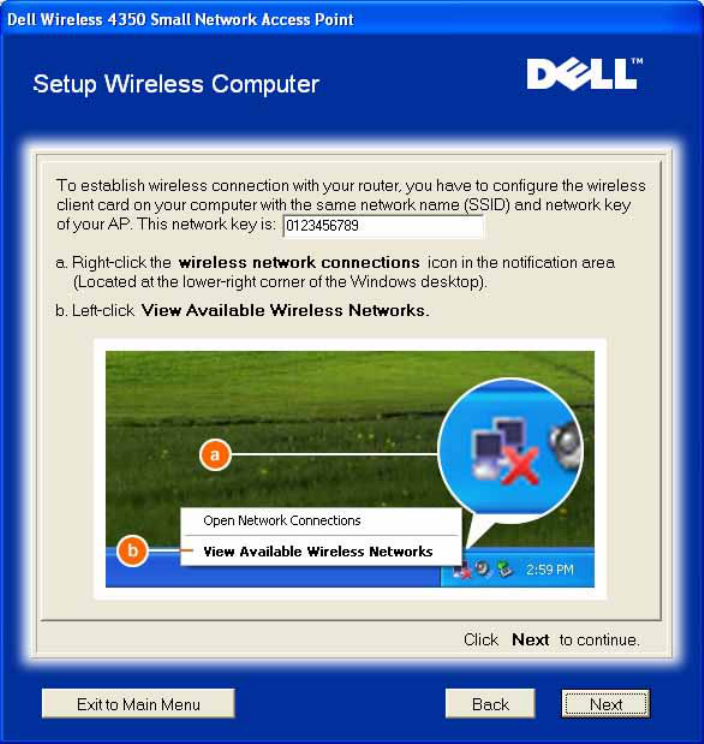
Step 4 guides the user through using the Windows wireless configuration utility to configure the
wireless client.
Setup Wireless Computer:
Step 4
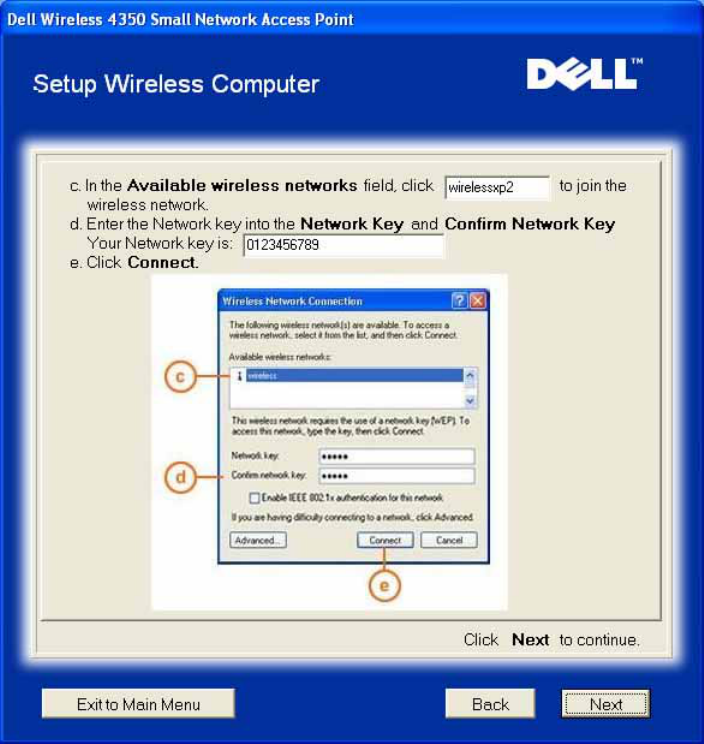
Step 5 guides the user through the remaining steps in using the Windows wireless configuration
utility to configure the wireless client.
Setup Wireless Computer:
Step 5
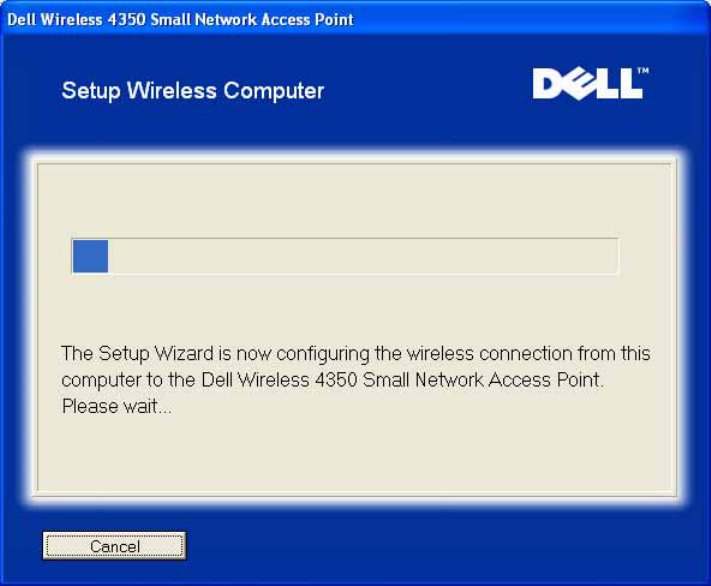
Step 6 informs the user to wait while the wireless client configuration is being verified.
Setup Wireless Computer: Step 6
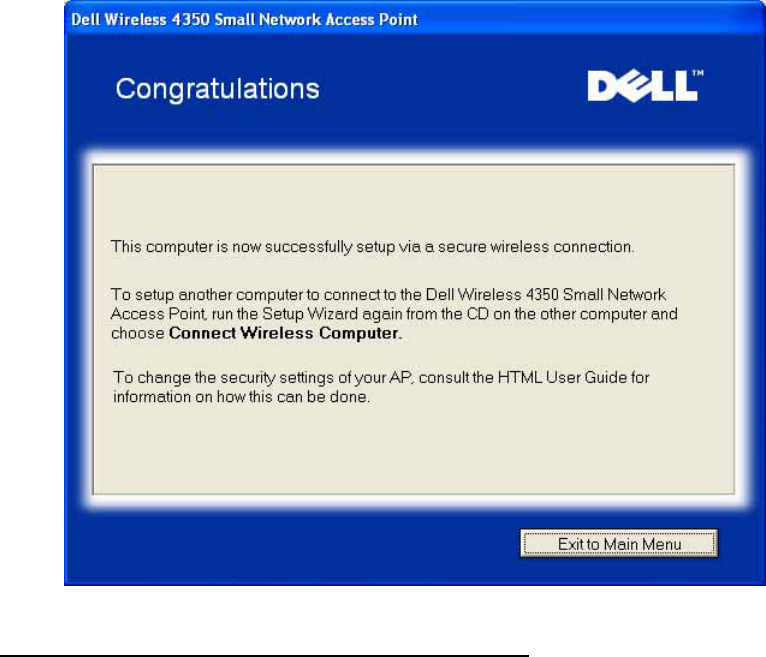
Step 7 informs the user that the wireless client is successfully configured and is now on the
wireless network.
Setup Wireless Computer: Step 7
Setup Wireless Computer - Win XP SP2 (No Encryption)
Pressing the Setup Wireless Computer button displays instructions to connect computers to
the network through a wireless connection.
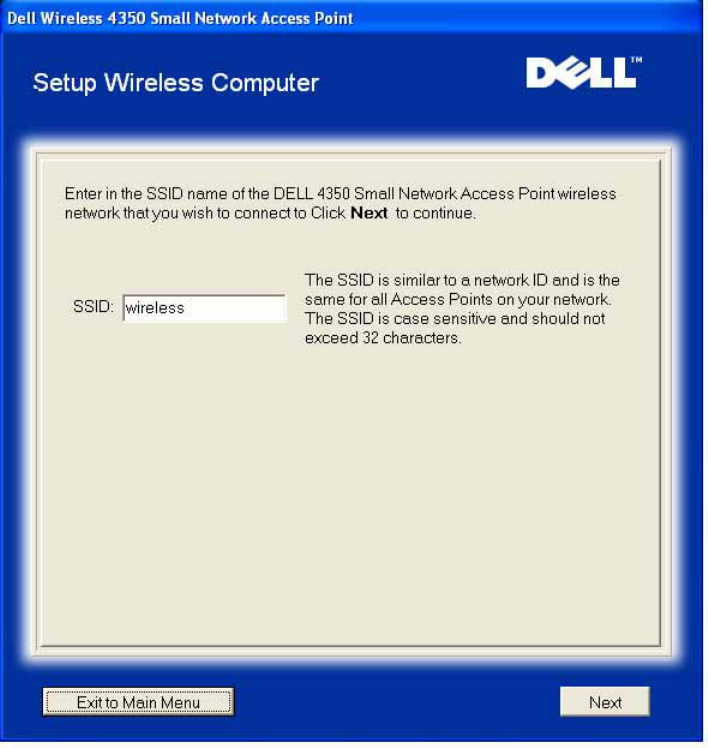
Step 1 asks the user to enter the SSID of the wireless network that you wish to connect to.
Setup Wireless Computer:
Step 1
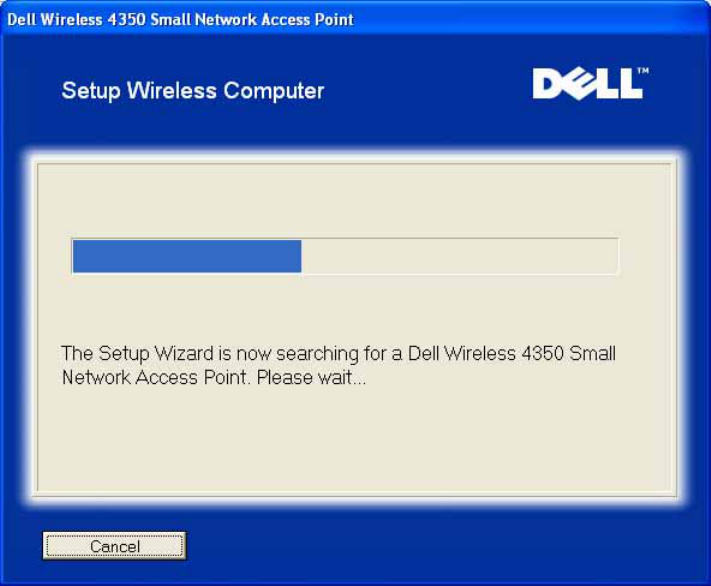
Step 2 asks the user to wait while the Setup Wizard does a site survey scanning for the
requested wireless network.
Setup Wireless Computer:
Step 2
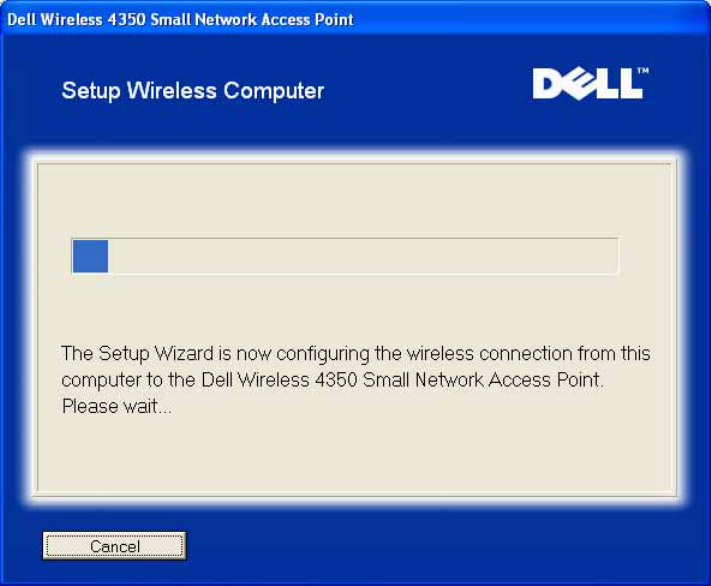
Step 3 informs the user to wait while the wireless client is being configured to join the network.
Setup Wireless Computer: Step 3
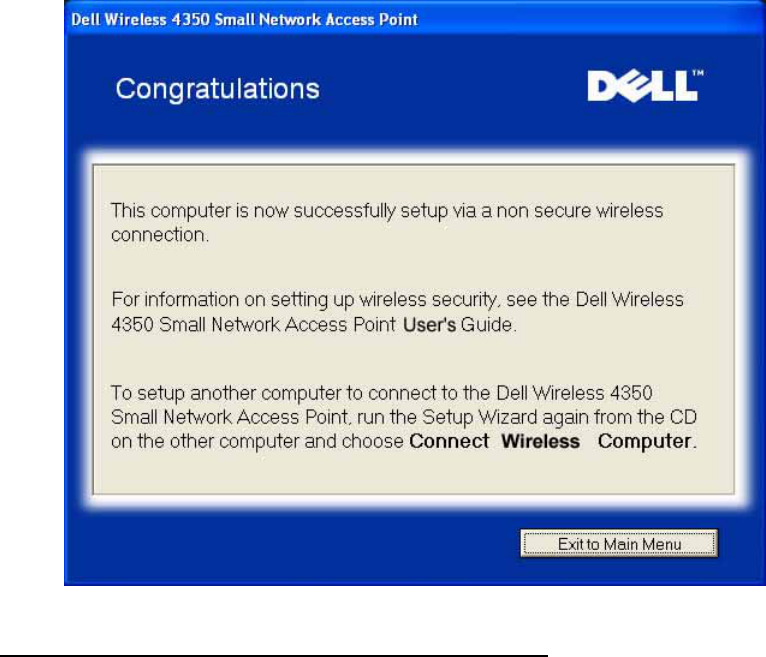
Step 4 informs the user that the wireless client is successfully configured and is now on the
wireless network.
Setup Wireless Computer: Step 4
Setup Wireless Computer - Win XP SP2 (WEP Encryption)
Pressing the Setup Wireless Computer button displays instructions to connect computers to
the network through a wireless connection.
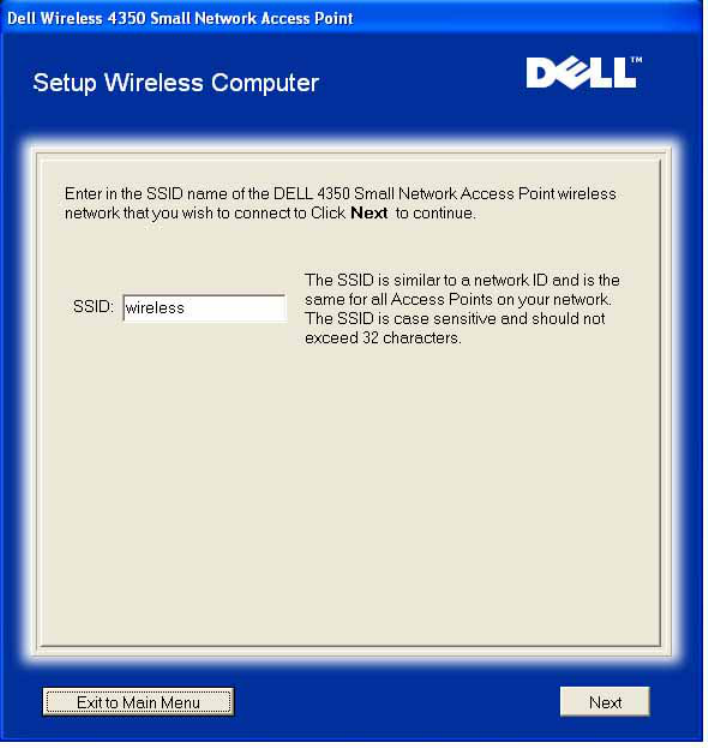
Step 1 asks the user to enter the SSID of the wireless network that you wish to connect to.
Setup Wireless Computer:
Step 1
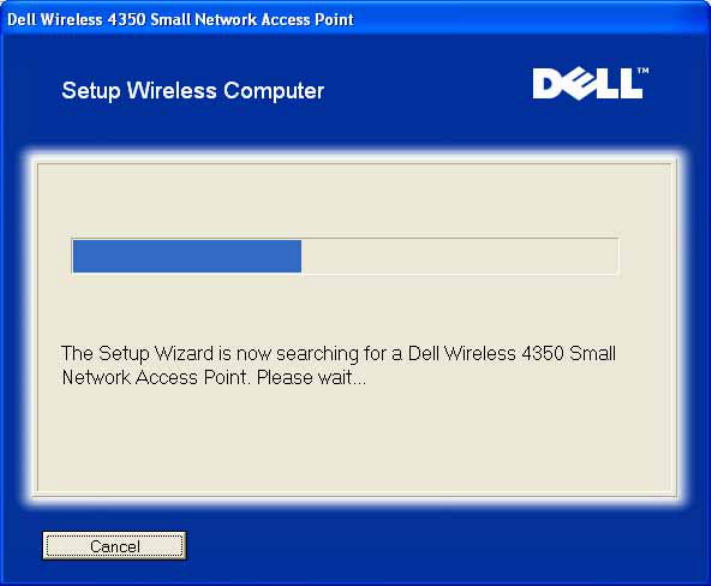
Step 2 asks the user to wait while the Setup Wizard does a site survey scanning for the
requested wireless network.
Setup Wireless Computer:
Step 2
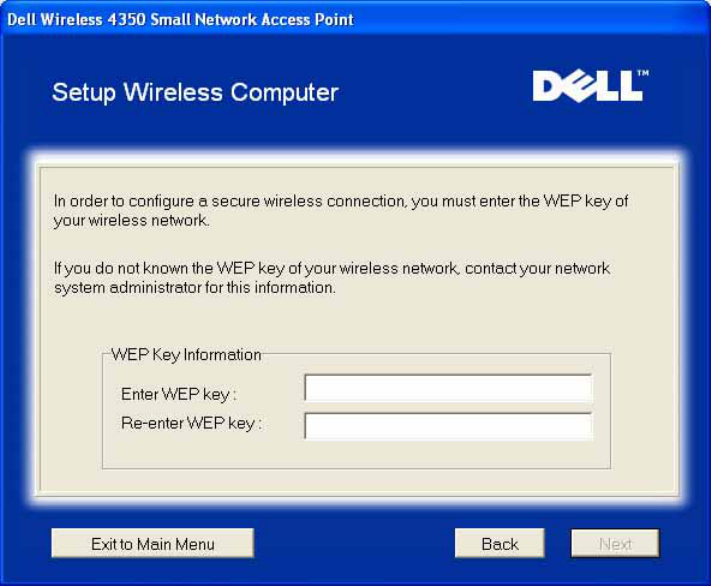
Step 3 asks the user to enter the WEP key of the wireless network that they wish to connect to.
Setup Wireless Computer:
Step 3
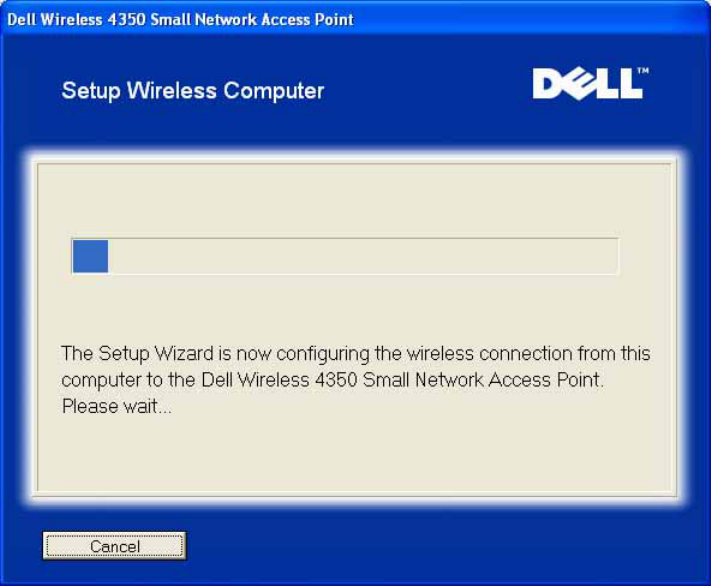
Step 4 informs the user to wait while the wireless client is being configured to join the network.
Setup Wireless Computer: Step 4
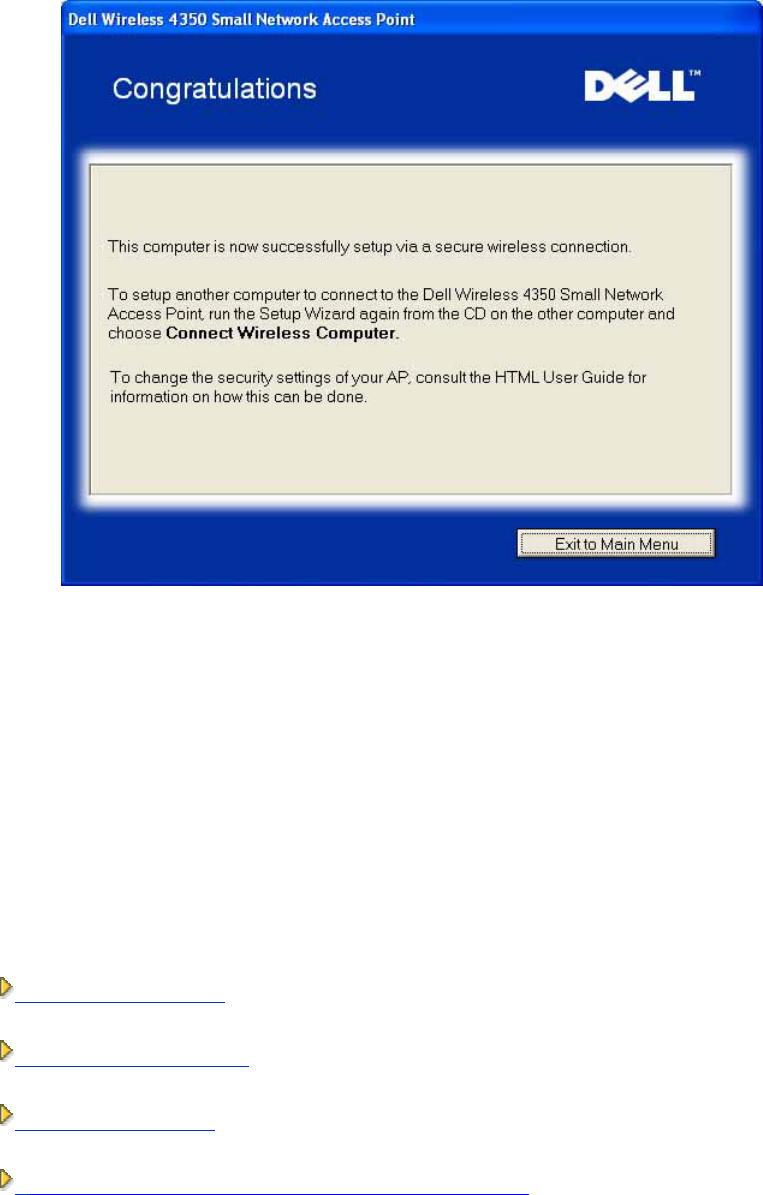
Step 5 informs the user that the wireless client is successfully configured and is now on the
wireless network.
Setup Wireless Computer: Step 5
Control Utility:
Dell™ Wireless 4350 Small Network Access Point
User's Guide
The Control Utility is Windows-based software that allows you to configure your Access Point
and monitor the status of your Dell Wireless 4350 Small Network Access Point.
Install the Control Utility
Uninstall the Control Utility
Start the Control Utility
Using the Control Utility to manage multiple Access Points

Exit the Control Utility
How to configure the Access Point via the Control Utility ?
Install the Control Utility
You can install the Control Utility on your computer from your Dell Wireless 4350 Small Network
Access Point CD .
1. Insert the Dell Wireless 4350 Small Network Access Point CD into the CD drive. Your CD
should automatically launch the Setup Wizard program. If it does not, complete the following
steps to start the Wizard.
a. Click the Start button, and then click Run.
b. Type the following text in the Open: field: X:\setup.exe (where X is the
drive letter of your CD drive).
c. Click the OK button.
2. From the main menu, click the Install Control Utility button.
3. Follow the on-screen instructions.
Uninstall the Control Utility
1. If the Dell Wireless 4350 Small Network Access Point icon is displayed in the system tray
in the lower right corner of the screen, right-click the icon and click Exit.
2. Click the Start button.
3. Click Control Panel. The Control Panel window appears.
4. Click the Add/Remove Programs icon.
5. Click to select the Control Utility from the program list and remove it as instructed.

Start the Control Utility
The control utility program will run automatically upon each computer startup by default. If the
utility does not start automatically, run the Dell Wireless 4350 Small Network Access Point
Dell Control Utility from the Start menu.
Once running, a access point icon is created in the system tray in the lower right corner of your
screen. If you have a connection to the access point, the system tray icon looks gray and white
. You can double-click the icon to open the utility panel.
NOTE: If the icon is red , it indicates that the connection to the access point failed.
Using the Control Utility to manage multiple Access Points
The control utility program can be used to manage multiple Dell Wireless 4350 Small Network
Access Points. When the Control Utility launches it will connect to the last access point
configured. If you wish to configure an alternative Dell Wireless 4350 Small Network Access
Point on the network, then follow the instructions below.
1. Start the Dell Wireless 4350 Small Network Access Point Control Utility.
2. In the My Network Overview tab, enable the Configure Alternative AP checkbox.
3. Enter the IP address of the alternative Dell Wireless 4350 Small Network Access Point that
you wish to configure in the IP Address field.
4. Click Apply
5. The Control Utility will then shutdown. After restarting the Control Utility, it will have
connected to the alternative Dell Wireless 4350 Small Network Access Point.
Exit the Control Utility
When you start the control utility program, it will place a small gray and white icon in the
system tray in the lower right corner of your screen. If you want to exit the program, right-click
the icon, and then left-click Exit to quit the program.

How to Configure the Access Point via the Control
Utility:
My Network Overview
Wireless Settings
Network Access Control
Administration
Diagnostics
Advanced Settings
My Network Overview
This screen provides information about your network connection and settings. The left pane
displays your connection status. The right pane displays the following network settings:
• Operation Mode
• LAN IP Address
• LAN Subnet Mask
• Network Name (SSID)
• Wireless Security
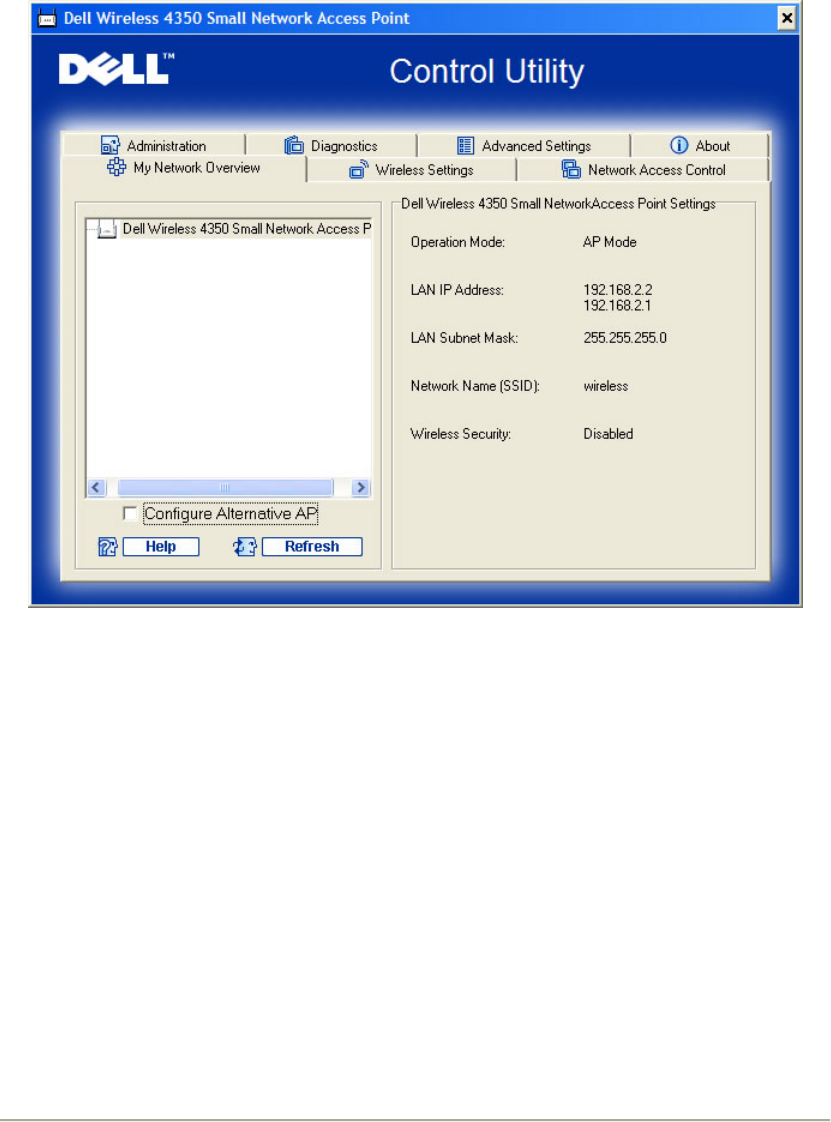
My Network Overview
The Control Utility allows the user to manage multiple Dell Wireless 4350 Small Network
Access Points on the network by allowing the user to configure an alternative access point to
the default access point presented by the Control Utility.
To configure an alternative access point, perform the following steps:
1. Click to select Configure Alternative AP.
2. Enter the IP Address and Subnet Mask of the access point to be configured into the IP
Address and Subnet Mask fields.
3. Click Apply, the Control Utility will shutdown and after restarting will have connected to the
desired Dell Wireless 4350 Small Network Access Point.
Wireless Settings
• Network Name (SSID)
The SSID is a unique network name. It is used to identify the wireless network. This name is
used when connecting wireless clients to your wireless network.
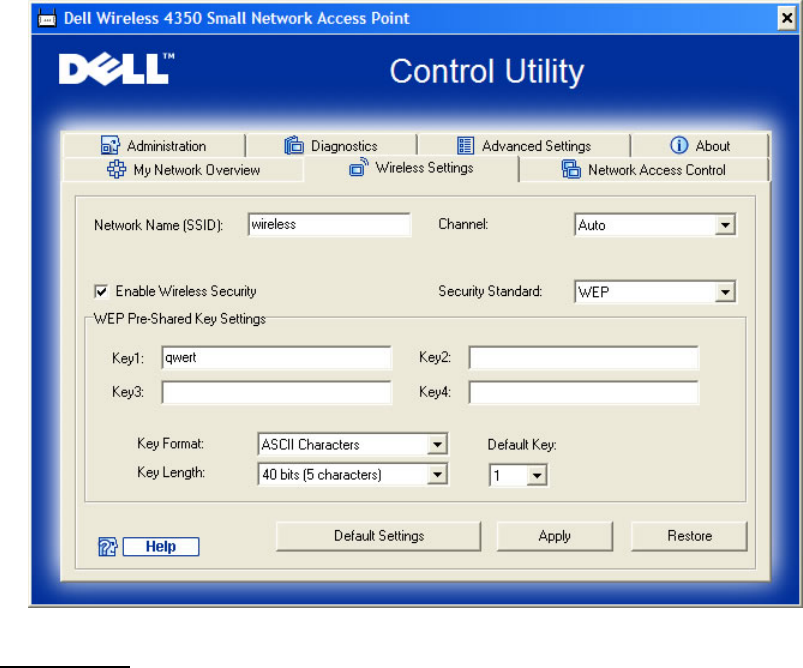
• Channel
This is the radio channel over which a communication transmission occurs between the access
point and a wireless client.
• Default Settings
Resets the wireless settings to its factory defaults.
• Apply
Saves current settings.
• Restore
Restores previous settings.
Your Dell Wireless 4350 Small Network Access Point has an advanced security mechanism. It
ensures the confidentiality of data, and also guards data against being modified. If you want to
enable the security mechanism, click to select Enable Wireless Security.
Wireless Settings WEP
WEP Settings
The Wired Equivalent Privacy (WEP) encryption defined in the 802.11 standard is used to
protect wireless communication from eavesdropping. WEP provides a way of creating an
encrypted key that is shared between a wireless client (such as a notebook with a wireless PC
card) and the access point. This key encrypts data before it is transmitted. WEP can be
implemented with a 40(64)-bit or 104(128)-bit key. For added security, change your key often.
When you change the key on one wireless device, it must be changed for all wireless devices
and access points in the network.
• Key Format
Can be ASCII or hexadecimal format. Hexadecimal format includes the numbers 0 through 9
and the letters A through F. ASCII format includes all alphanumeric characters.
• Key Length
Can be either 40(64)-bit or 104(128)-bit key length. Some wireless network cards are only able
to use 40(64)-bit encryption. If all your clients are able to communicate at 104(128)-bit, then
choose 104(128)-bit. If any client is only able to communicate at 40(64)-bit, choose 40(64)-bit.
• Key1, Key2, Key3, and Key4
Type four different keys in the Key fields provided to store on the Wireless 2350. If you choose
40(64)-bit encryption, enter a 5-character (or 10 hexadecimal digits). For 104(128)-bit
encryption, enter a 13-character (or 26 hexadecimal digits) WEP key.
• Default Key
Select only one key out of the four provided in the Default Key field.
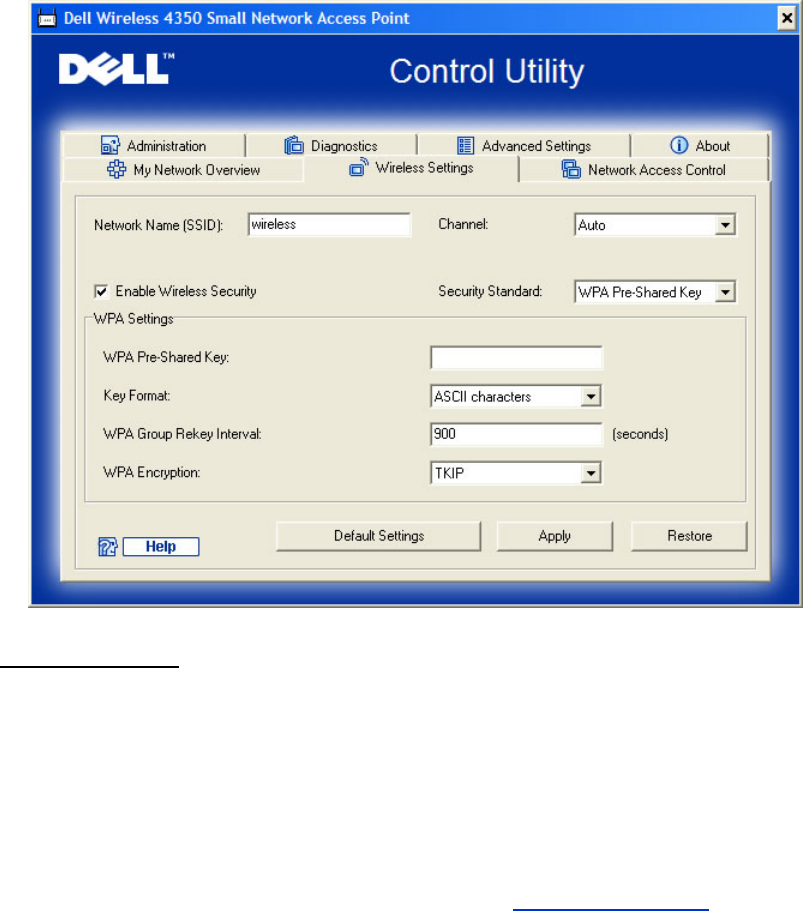
Wireless Settings WPA-PSK
WPA-PSK Settings
Wi-Fi Protected Access (WPA) is an upgrade to the WEP standard for securing your wireless
network.
If you would like to secure your wireless network using WPA, you must have WPA support for
your wireless clients. If you are using a Dell wireless client, you can check for the availability of
WPA-enabled software updates for your wireless client at http://support.dell.com.
• WPA Pre-shared Key
All wireless clients must use this key to gain access to the network. Note that the Key format
must also match the setting for the wireless clients.
• Key Format
Can be ASCII or hexadecimal format. Hexadecimal format includes the numbers 0 through 9
and the letters A through F. ASCII format includes all alphanumeric characters.
• WPA Group Rekey Interval
WPA Group Rekey Interval is used to specify the frequency of encryption key rotations. The
lower the number, the faster your encryption key will rotate; however, setting this number too
low may cause your wireless network to slow down.
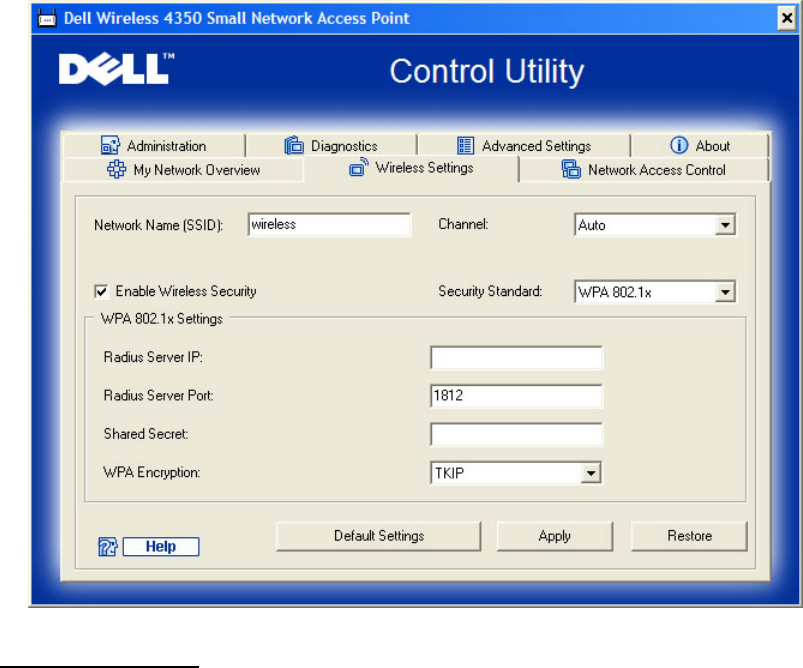
• WPA Encryption
TKIP (Temporal Key Integrity Protocol) is the most commonly used encryption method. AES
(Advanced Encryption Standard) can be used if your wireless clients do not support TKIP.
Wireless Settings WPA 802.1x
WPA-802.1x Settings
• Radius Server IP, Radius Server Port and Shared Secret.
The Radius Server IP, Radius Server Port and Shared Secret fields required to be populated
with the relevant information. This information regarding the Radius authentication server can
be obtained from the network administrator.
• WPA Encryption
WPA Encryption allows you to select one of two possible encryption methods—TKIP and AES.
Choose one that your wireless clients support.
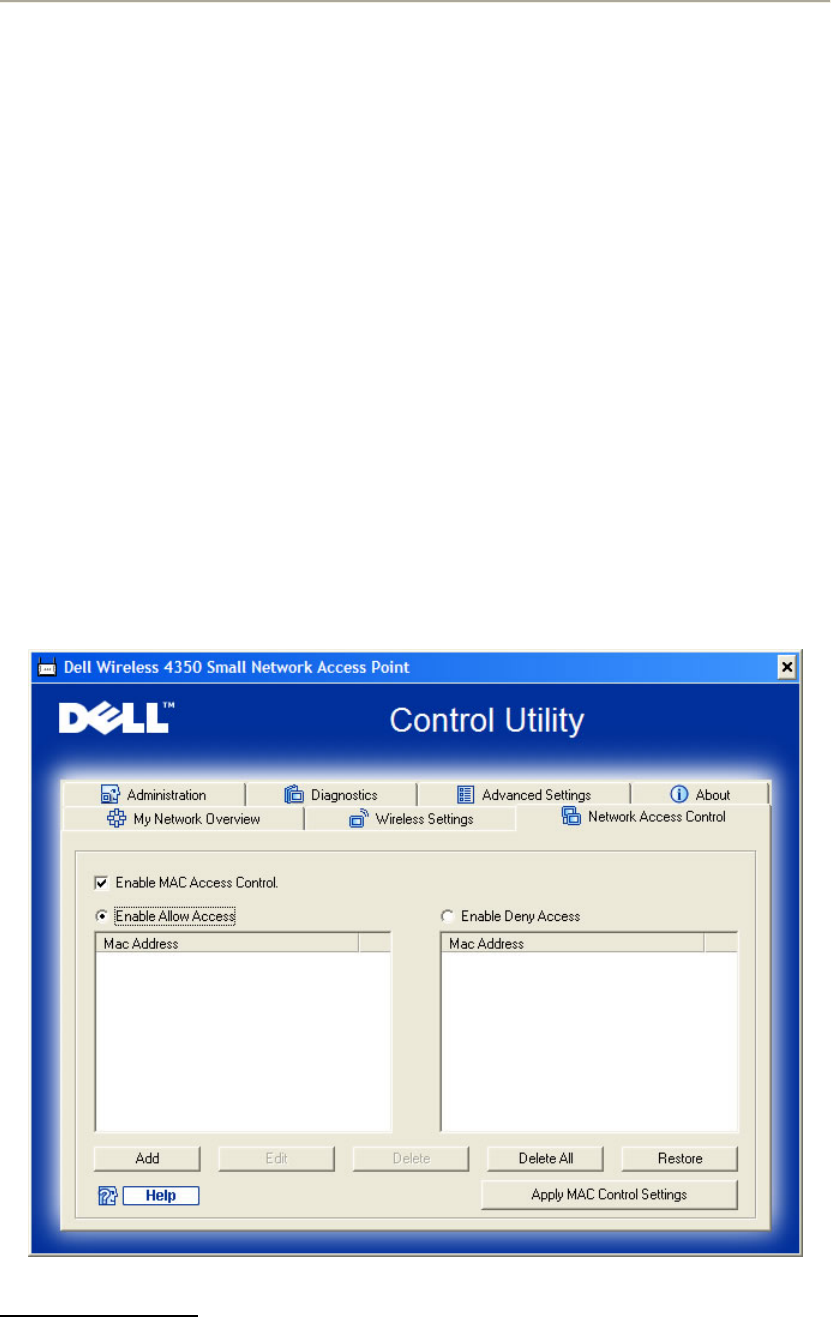
Network Access Control
• Add
Adds a new entry to the list.
• Edit
Allows you to edit entries.
• Delete
Deletes a record from the list.
• Delete All
Deletes all records from the list.
• Restore
Restores previous settings.
Network Access Control
MAC Access Control

The MAC Access Control page allows you to control which local client computer is allowed to
access the network through the Dell Wireless 4350 Small Network Access Point based on the
client computer’s MAC address. The default setting is to allow any client computer to access
the network through the access point.
There are two options for the Access Control Settings, the Allow Access option and the Deny
Access option. Each option is able to support up to 32 entries. Only one option can be active at
any time. Selecting the checkbox for Enable Allow Access will disable Enable Deny Access and
vice versa. The Enable Allow Access option will only allow clients that are listed in the table to
access the network. The Enable Deny Access option will prevent any clients that are listed in
the table from accessing the network.
To enable MAC Access Control, perform the following steps:
1. Click to select Enable MAC Access Control.
2. Click the appropriate option, Enable Allow Access or Enable Deny Access.
3. Click the Add button. The MAC Access Control: Add a Record window appears.
4. Enter the hexadecimal MAC address (for example, 00:11:22:33:44:55) that you want to
grant or deny access in the Host MAC box.
5. Click the OK button to apply, or click the Cancel button to exit without making any
changes.
6. You can click on the selected record and click again on its Host Name to enter the desired
name for this record.
7. Click the Apply MAC Control Settings button on the bottom of the screen to activate the
new settings.
Administration
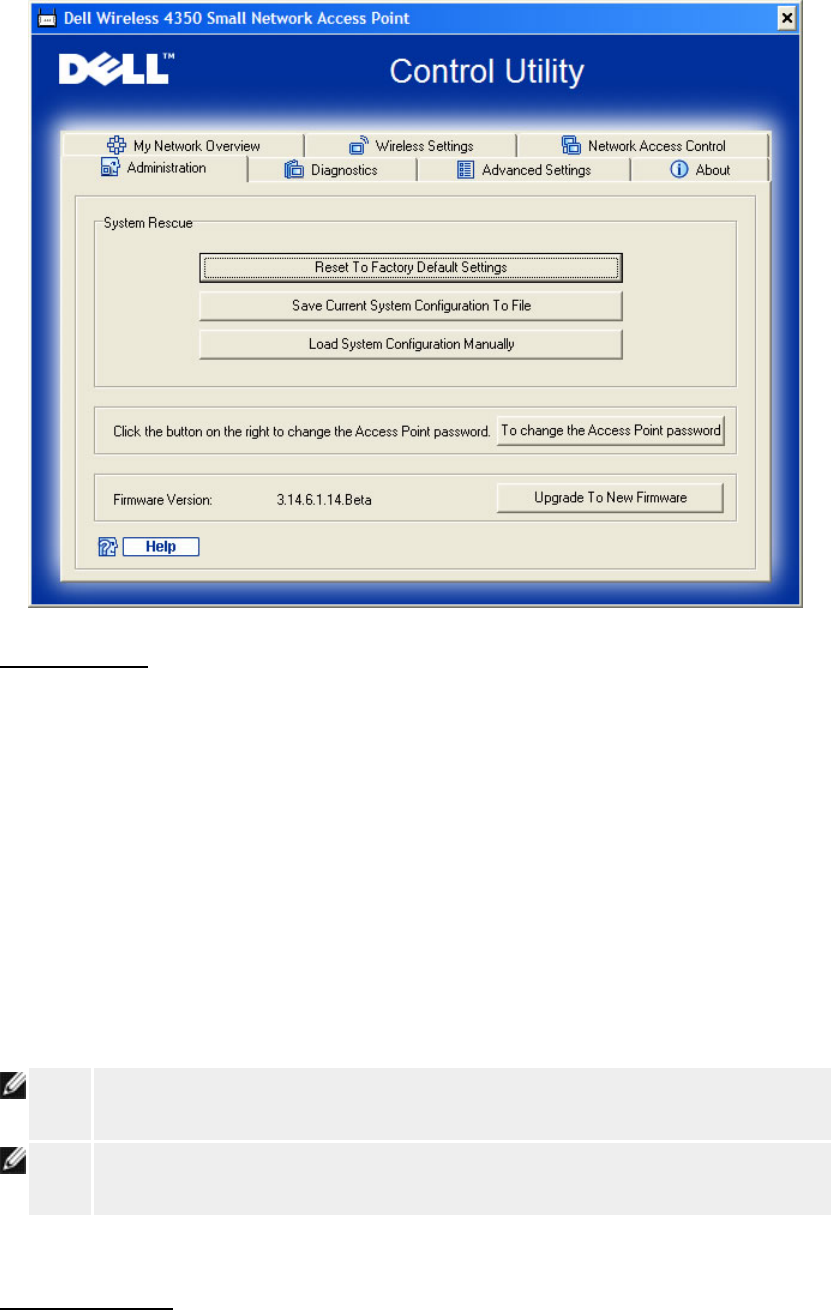
Administration
System Rescue
System Rescue allows you to save a backup of your configuration settings.
• Save Current System Configuration To File
Saves the current settings as a .pro file.
• Load System Configuration Manually
Loads the backup file to restore previously saved settings.
• Reset to Factory Default Settings
Resets the router to its default configuration.
NOTE: The system configuration files can only be used by the Control Utility on Dell
Wireless 4350 Small Network Access Points.
NOTE: Do not use the Control Utility to import configurations settings files created by the
web based configuration tool.
Change Password

To prevent unauthorized administration changes to the access point, the access point is
password protected. It is strongly recommended that you change the factory default password.
1. Click the To Change the Access Point Password button. The Password Settings
window appears.
2. Type the original password in the Original Password field.
3. Type the new password in the New Password field, and then retype it in the Confirm
Password field to verify.
4. Type the password hint message in the Password Hint Message field.
5. Click the Submit button when you finish the setting. If you want to clear any values you
have entered in any field, click the Cancel button.
Upgrade to New Firmware
If you are instructed to upgrade the firmware, click the Upgrade to New Firmware button. It will
connect to the Dell website to upgrade to the latest firmware release. It is unnecessary to
upgrade the firmware if your access point is working properly.
Diagnostics
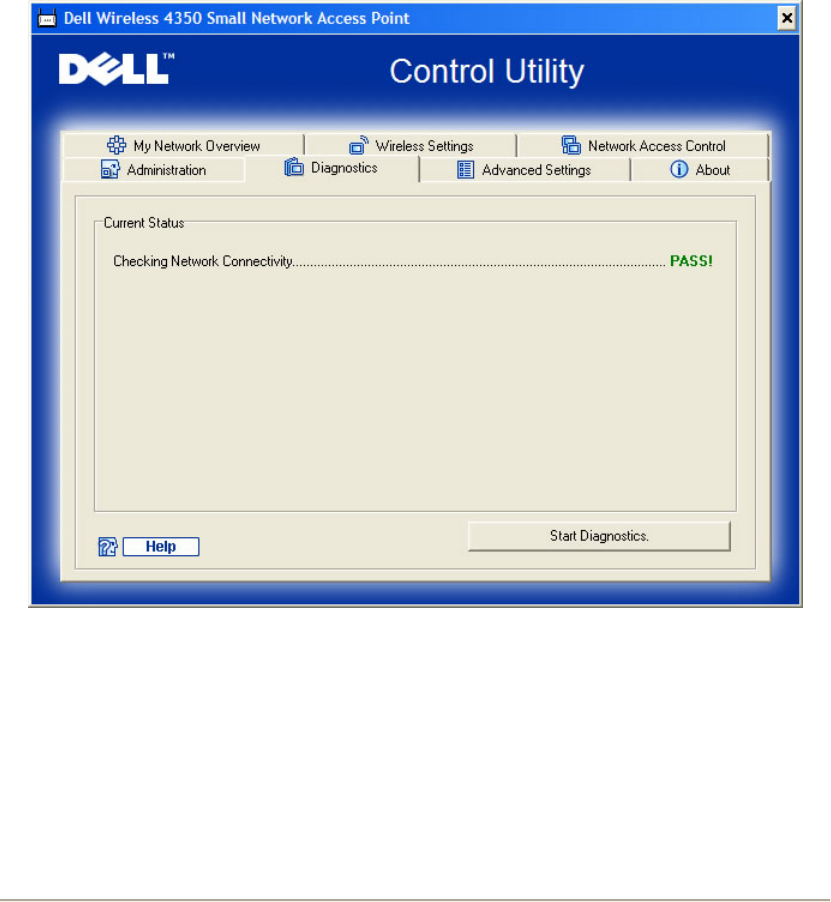
Diagnostics
You can monitor the current status of your network connection in the Diagnostics menu. The
network diagnostics can be activated by clicking the Start Diagnostics button on the bottom of
the screen.
When the detection is done, the screen will display either a PASS! or FAIL! message indicating
whether the access point is connected to a network or not.
Advanced Settings
Advanced Settings
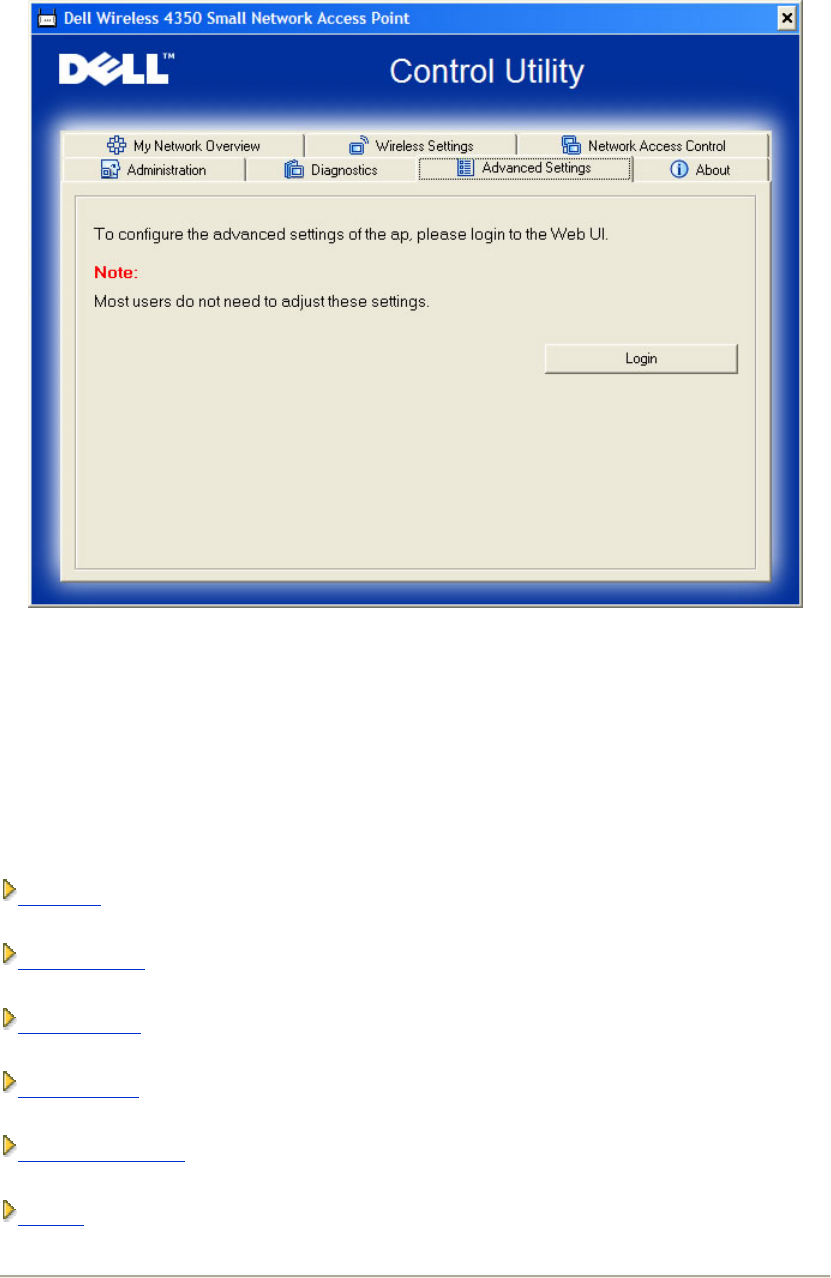
To configure the advanced settings of the access point, click the Login button to log in to the
web-based configuration tool. The web-based configuration tool allows you to set up advanced
network configurations for your Dell Wireless 4350 Small Network Access Point.
Web-based Configuration Tool:
Overview
Basic Settings
Device Status
System Tools
Advanced Settings
Log Off
Overview
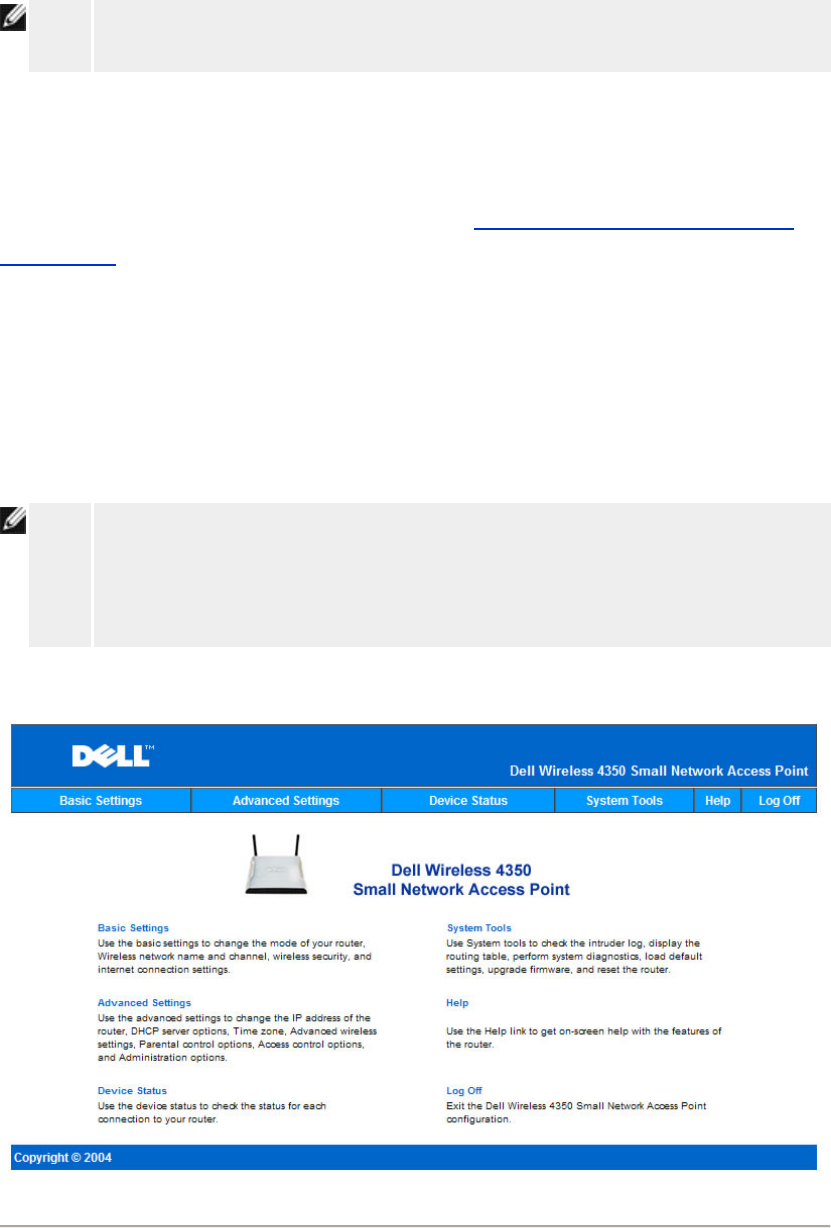
The web-based configuration tool enables you to set up advanced network configuration for
your Dell Wireless 4350 Small Network Access Point. Follow the instructions below to gain
access to the web tool.
NOTE: Microsoft Internet Explorer 4.0 or higher or Netscape 4.0 or higher must be used for
the web-based configuration tool.
1. Click the Start button, and then click Run.
2. Type the IP address of the Dell Wireless 4350 Small Network Access Point into the Open
box: (for information on obtaining this IP address see How to obtain the IP Address of the
Access Point).
3. If this is the first time configuring your Dell Wireless 4350 Small Network Access Point, or if
the user name and password have not been changed, type admin in the User Name and
Password fields.
4. Click the OK button. The Configuration screen appears.
NOTE: Dell technical support representatives do not support the configuration options in the
Advanced Settings portion of the configuration program. These options are
provided for your convenience only. However, the advanced settings are fully
documented and explained in this guide.
Main Menu

Log Off
The Log Off button logs the user off the web based configuration tool. This configuration tool
only allows access to one user at a time.
Basic Settings:
The following configuration options are included in Basic Settings:
General Settings
Wireless Settings
Wireless Security
Save & Apply
NOTE: To implement the changes you make to the settings, you must save your settings
and restart the access point. Otherwise, the access point uses the previous settings.
If you are using the BACK/NEXT links to step through each screen in the Basic
Settings portion of the web-configuration tool, you ultimately reach the Save &
Apply page. Click Save & Restart button to commit the changes, and the access
point will reboot automatically with the new settings in effect.
General Settings
The General Settings page allows the user to change the AP host name.
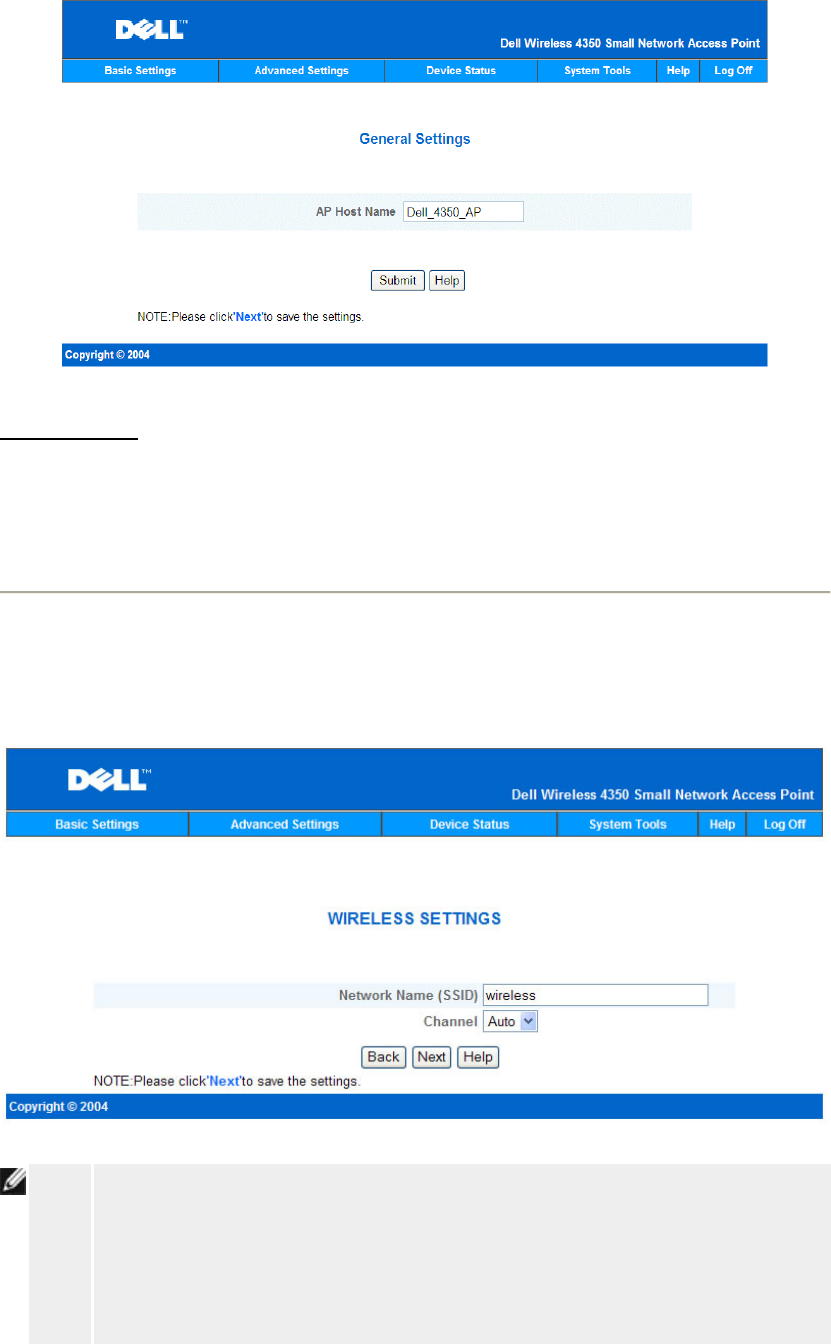
General Settings
AP Host Name
The AP Host Name is the network name that the Dell Wireless 4350 Small Network Access
Point will have on a network.
Wireless Settings
Wireless Settings
NOTE: You must change each client’s wireless adapter settings to match the Dell Wireless
4350 Small Network Access Point settings. Use the factory defaults for the access
point, unless the default settings have been changed. In this case, note the changes
and use the new settings for each wireless network card. For assistance configuring
a wireless network card, see the card’s documentation.

Setting Possible Values
Network Name (SSID) (wireless by default)
Channel (auto by default)
Network Name (SSID)
The network name is a value that identifies a collection of wireless devices found in a particular
network. The default value for the Dell Wireless 4350 Small Network Access Point is wireless.
All workstations and access points must use the same SSID to be able to communicate with
one another.
The SSID is a 32-character field, and the value is case sensitive.
Channel
The Dell Wireless 4350 Small Network Access Point can operate on a variety of channels.
Access points within close proximity to one another must be on different channels. If you have
just one access point, then the default, auto, is probably adequate. If you have multiple access
points in your network, it is suggested to stagger the channels for each access point. It is
advisable to use the default unless there is a specific reason for changing the channel, such as
interference from microwaves, cellular phone towers, or other access points in the area.
Wireless Security
Data encryption provides added security by encoding network communications using an
encryption key. Your Dell Wireless 4350 Small Network Access Point, in conjunction with
wireless network adapters that support encryption, can scramble your transmitted data to make
it difficult for someone to eavesdrop or intercept your information. Two methods of data
encryption are available: Wired Equivalent Privacy (WEP) and Wi-Fi Protected Access
(WPA). If you wish to enable wireless security, click to select Enable Wireless Security.
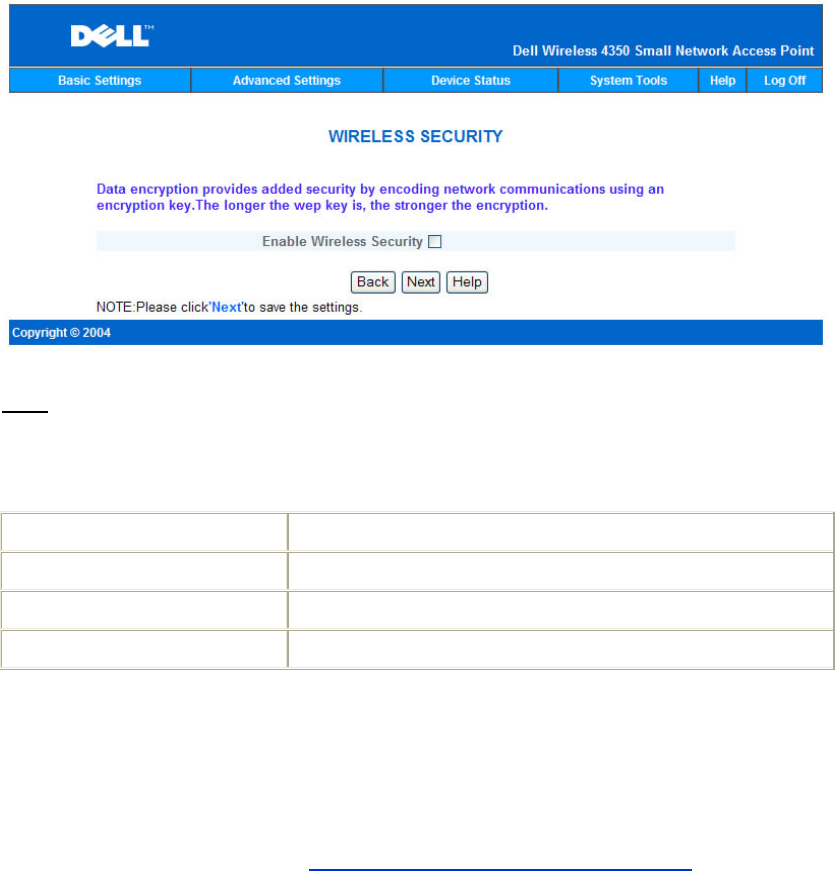
Wireless Security
WEP
If you wish to enable WEP encryption, click to select WEP in the Network Encryption list.
Setting Possible Values
Key Format Hexadecimal Digits / ASCII Characters
Key Length 40 bits (5 characters) / 104 bits (13 characters)
Key1, Key2, Key3, Key4 <user-defined>
There are two levels of WEP encryption: 40(64)-bit and 104(128)-bit, with 104(128)-bit being
the more secure of the two. The WEP encryption keys are simply a set of hexadecimal numbers
or ASCII characters that you choose. Each Dell Wireless 4350 Small Network Access Point and
every wireless workstation must use the same WEP encryption key to communicate. For more
information on encryption, see the Wireless Networking Overview - Encryption section of this
user's guide.
• Key Format
Key format can be in ASCII or hexadecimal format. Hexadecimal digits include the numbers 0
through 9 and the letters A through F. If you select ASCII format, you can enter any character.
• Key Length
Key length can be either 40(64)-bit or 104(128)-bit. Larger key lengths are more secure. Some
wireless network cards are only able to use 40(64)-bit encryption. If all your clients are able to
communicate at 104(128)-bit, choose 104(128)-bit.
• Key
If you choose 40(64)-bit encryption, enter a 5-character (or 10 hexadecimal digits) WEP
encryption Key in the fields provided. For 104(128)-bit encryption, enter a 13-character (or 26
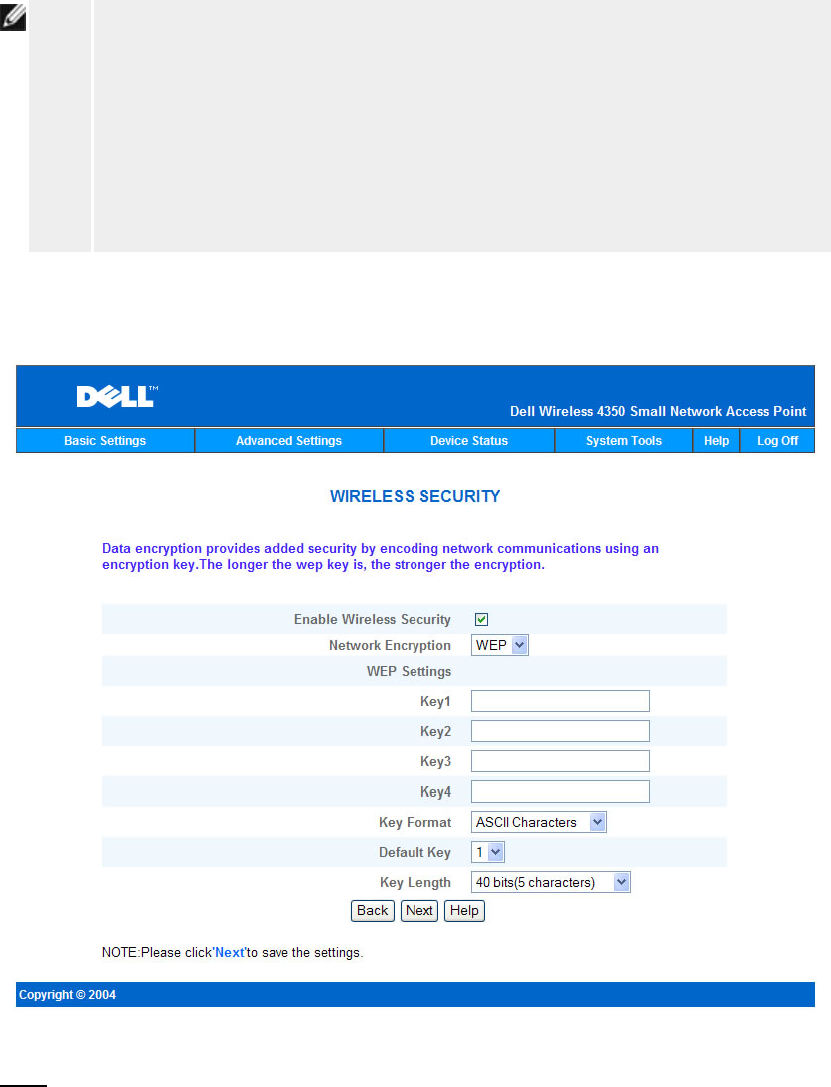
hexadecimal digits) WEP key in the fields provided. You have the option of entering four
different keys to store on the Wireless 4350. Select only one key out of the four provided in the
Default Key drop-down list. For added security, change your key often. When you change the
key on one wireless device, remember that it must be changed for all wireless devices and
access points in the network.
NOTE: If you are adding the Dell Wireless 4350 Small Network Access Point to an existing
network and will be using an existing encryption key for the wireless clients, contact
the person in charge of the network. The same key must be used when configuring
the encryption for the Dell Wireless 4350 Small Network Access Point. The
administrator must make any changes to all access points and wireless clients on a
network. Changing the key on just one access point or wireless client disconnects it
from the rest of the network.
Wireless Security
WPA
If you wish to enable WPA encryption, select WPA from the Network Encryption list.

WPA is an upgrade to the WEP standard for securing your wireless network. If you would like to
secure your wireless network using WPA, you must have WPA support for your wireless clients.
If you are using a Dell Wireless wireless client, you can check for the availability of
WPA-enabled software update for your wireless client at http://support.dell.com.
There are two options for network authentication (a) Pre-shared key or (b) 802.1x . Typically, in
enterprises, WPA will be used in conjunction with a RADIUS authentication server. In a Small
Office/Home Office (SOHO) environment, where there is no authentication server, users can
use pre-shared key (PSK) mode in place of the authentication server
The Dell Wireless 4350 Small Network Access Point offers both WPA running in PSK mode and
WPA with 802.1x authentication.
WPA Pre-shared Key
WPA Pre-Shared Key (PSK) is a field where the password is entered. All wireless clients must
also use this password to gain access to the network. Note that the Key format must also match
the setting for the wireless clients.
• Key Format
Key Format is a box that lists 2 items: Hexadecimal Digits (numbers 0 through 9 and letters A
through F) and ASCII Characters (any letter, number, or symbol). Select the proper format for
your key. If your wireless client(s) only support one of the two formats, be sure to specify the
correct one.
• WPA Group Rekey Interval
WPA Group Rekey Interval is used to specify the frequency of encryption key rotations. The
lower the number, the faster your encryption key will rotate, however, setting this number too
low may cause your wireless network to slow down.
• WPA Encryption
WPA Encryption has 2 choices: TKIP (Temporal Key Integrity Protocol) is the most commonly
used encryption method. AES (Advanced Encryption Standard) can be used if your wireless
clients do not support TKIP.
WPA PSK
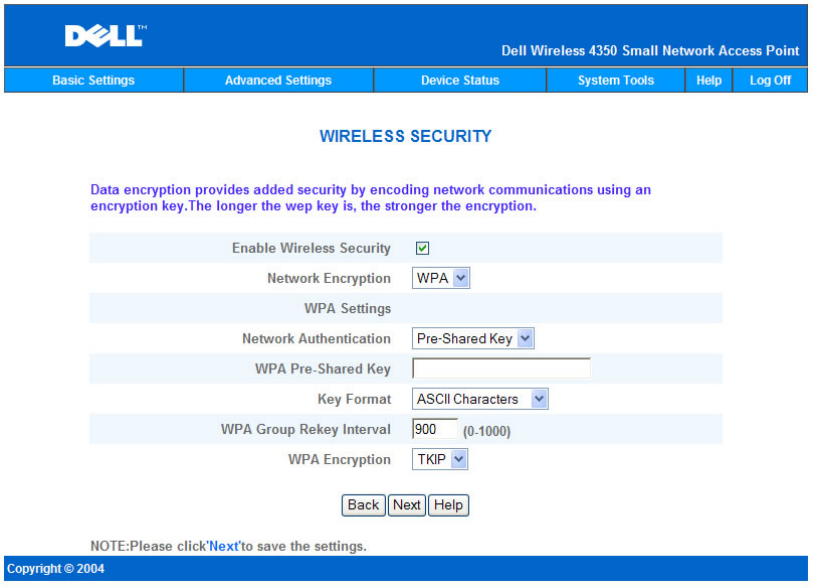
WPA 802.1x
WPA-802.1x requires the network to have an authentication server. All wireless clients must
have an authentication certificate in order to gain access to the network.
• Radius Server IP, Radius Server Port and Shared Secret
The Radius Server IP, Radius Server Port and Shared Secret fields are required to be
populated with the relevant information. This information regarding the Radius authentication
server can be obtained from the network administrator.
• WPA Group Rekey Interval
WPA Group Rekey Interval is used to specify the frequency of encryption key rotations. The
lower the number, the faster your encryption key will rotate, however, setting this number too
low may cause your wireless network to slow down.
• WPA Encryption WPA Encryption has 2 choices: TKIP (Temporal Key Integrity Protocol)
is the most commonly used encryption method. AES (Advanced Encryption Standard) can be
used if your wireless clients do not support TKIP.
WPA 802.1x
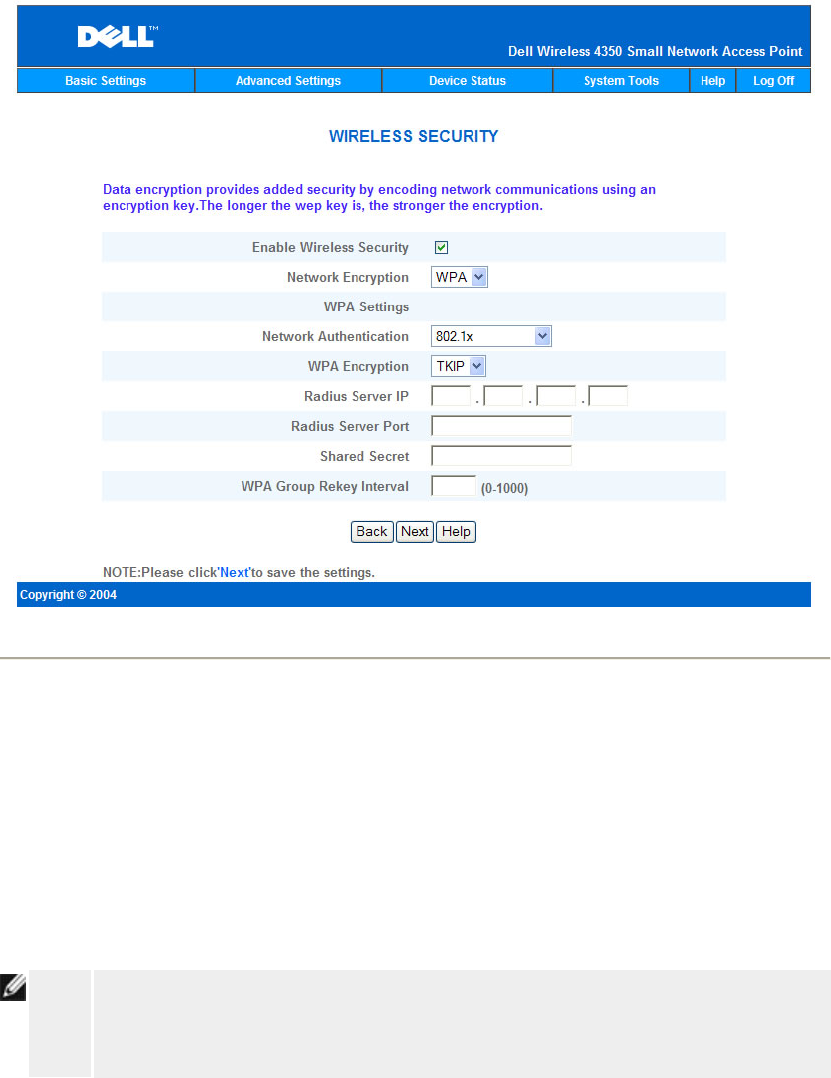
Save & Apply
Use the Save & Apply page to submit all the network setting changes you have made. Click
the Save & Restart button to update the network configurations for your Dell Wireless 4350
Small Network Access Point.
The new settings are then written to the firmware, and the access point reboots automatically.
NOTE: If you have wireless clients on your network, you must configure the clients' wireless
network cards to match the settings for the Dell Wireless 4350 Small Network
Access Point.
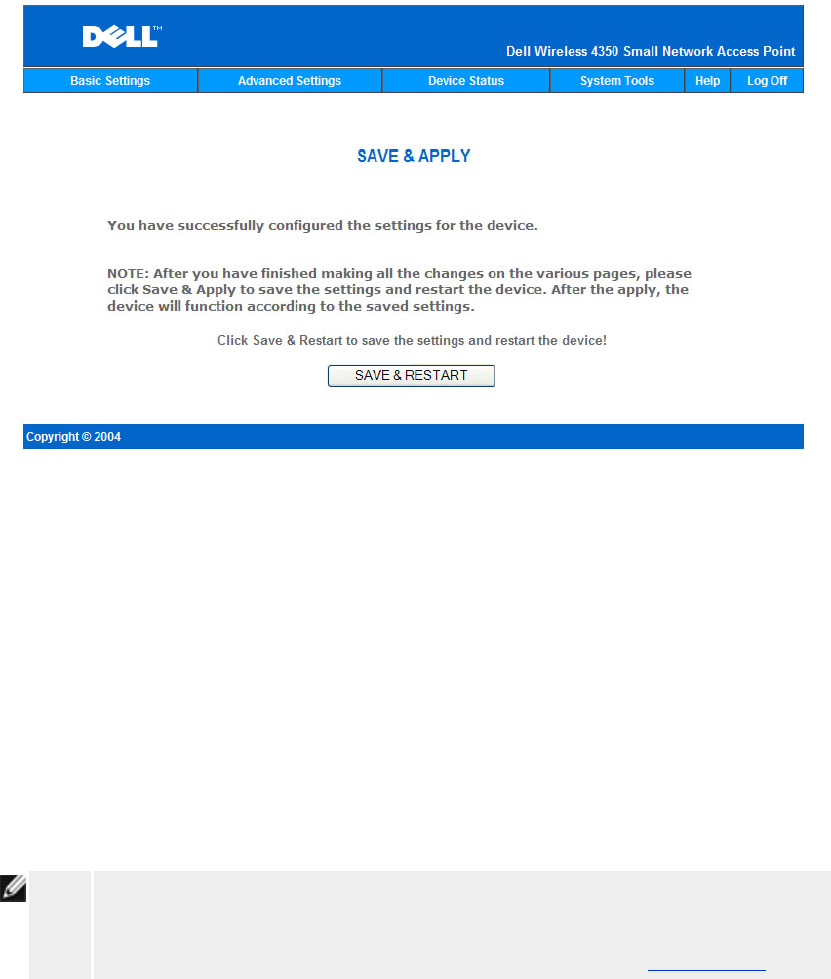
Save and Apply
Device Status:
The Device Status screen displays the basic network settings for your Dell Wireless 4350 Small
Network Access Point. When changes are made to the network settings, those changes are
updated on this screen. In addition, it graphically displays the current connection status for the
access point and other devices in your network. Connections between network devices are
shown with a yellow arrow. Inoperative connections are represented by one red X through the
yellow connection line.
NOTE: The Dell Wireless 4350 Small Network Access Point offers two ways to check the
status of your network. One is the Device Status feature in the web configuration
tool mentioned here. The other is through the Windows-based Control Utility.
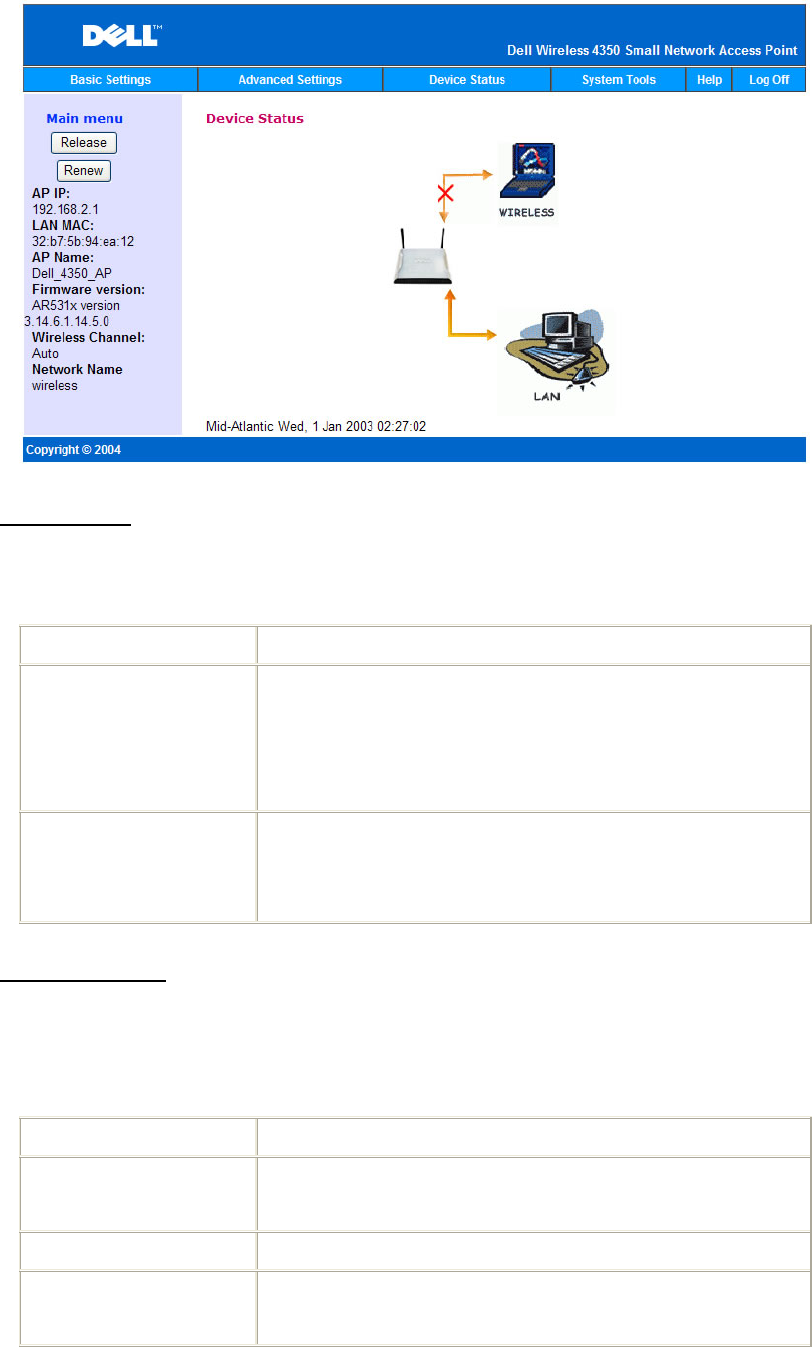
Device Status
Device Status
The following connections are displayed on the Device Status page:
Device Indication
Dell Wireless 4350 Small
Network Access Point
Shown as an active connection when the Dell Wireless 4350
Small Network Access Point is configured and physically
connected to your network, and inactive when the Ethernet
cable is disconnected from the network.
Wireless Client
Shown as an active connection when a wireless client is
connected to your access point, and inactive when there is no
wireless client connected to your access point.
Ethernet Settings
Refer to the left side of the screen for the following LAN Ethernet settings and the Internet
protocol (IP) settings for the Dell Wireless 4350 Small Network Access Point:
Setting/Device Information Displayed
AP IP The IP address assigned to the Dell Wireless 4350 Small
Network Access Point
LAN MAC The MAC address for the LAN (Ethernet) interface
AP Host Name The host name for the Dell Wireless 4350 Small Network
Access Point (the default is Del_4350_AP)

Firmware Version The version number of the firmware currently installed on the
Dell Wireless 4350 Small Network Access Point
Wireless Channel The radio channel on which the Dell Wireless 4350 Small
Network Access Point is communicating on the air
Network Name
A
unique network name that identifies the wireless network. It is
also known as SSID (Service Set Identifer). When a client
station tries to connect to the access point, the user must know
the access point's SSID first.
The following buttons appear on the left navigation bar:
Button Action
Release
Releases the IP address that the Dell Wireless 4350 Small
Network Access Point has been assigned from your network's
DHCP server. If the access point has been configured to have
a static IP address, clicking Release does not release this IP
address.
Renew
Renews the IP address from your network's DHCP server. If
the access point has been configured to have a static IP
address, clicking Renew does not renew the IP address.
System Tools:
Use the System Tools section to view the intruder detection log, the network activity log,
system statistics and system diagnostics regarding the device. The System Tools section also
includes features to import/export the device’s configuration settings, restore the default
settings, upgrade the firmware and reset the device.
Use the following pages in the web-based configuration tool to access these features in the
System Tools:
Intruder Detection Log
Network Activity Log
Import/Export Settings
System Statistics
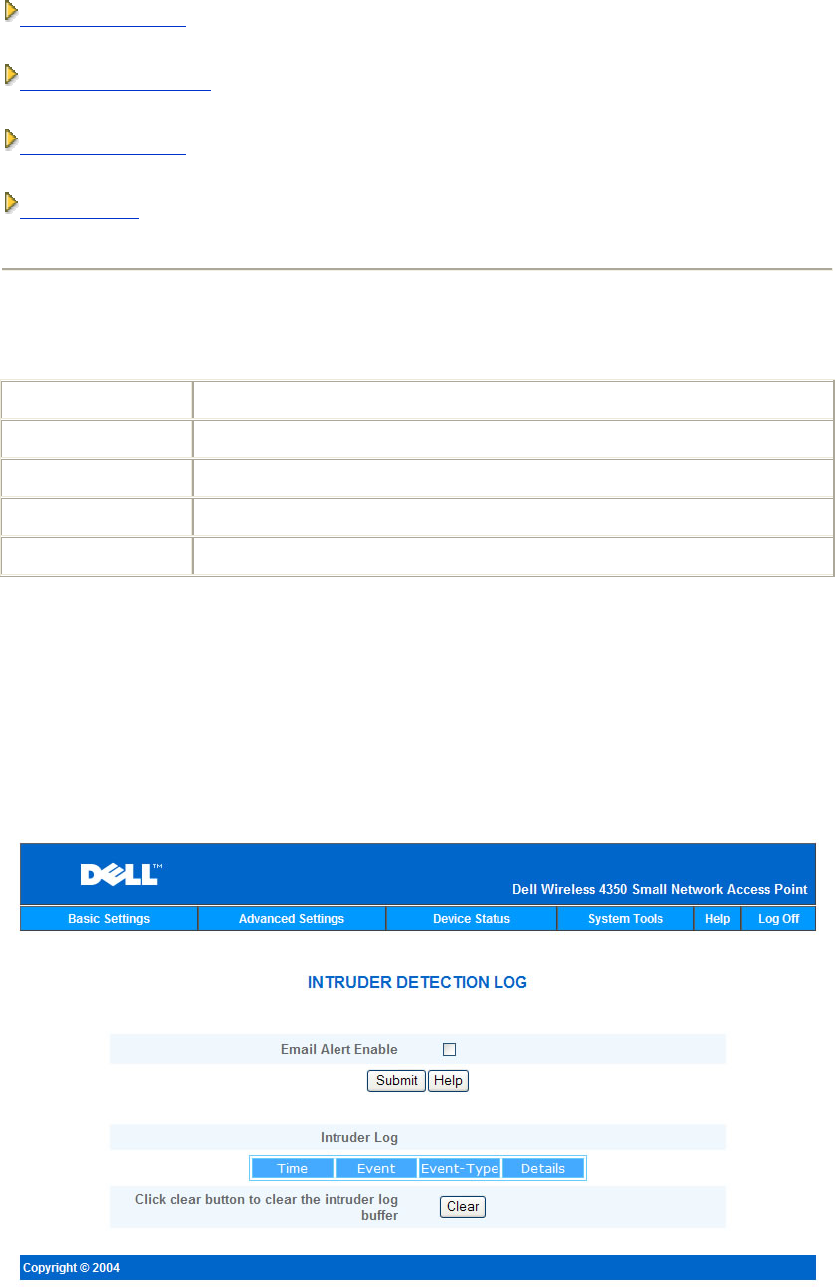
System Diagnostic
Load Default Settings
Upgrade Firmware
Reset Device
Intruder Detection Log
Indicator Description
Time Based on the timestamp of the IP packet, plus or minus the time offset
Event Type of attack that the access point detects
Event-Type Type of attack that the access point detects
Details Shows detailed information about the event
The system can be enabled to alert an administrator via e-mail of any attempted intrusion.
1. Click to select Email Alert Enable.
2. Type the e-mail address that you want the alert sent to in the Email Address field.
3. Click the Submit button.
Intrusion
Network Activity Log
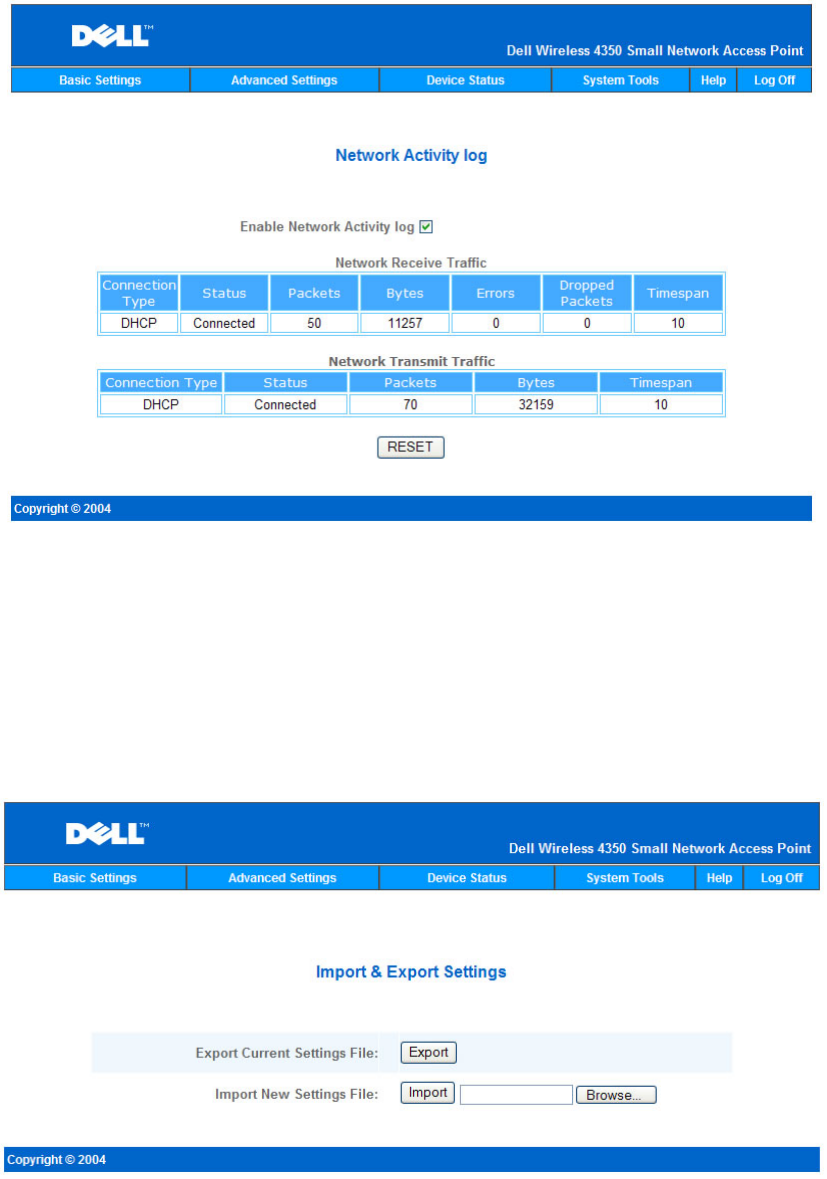
Network Activity Log
Click to select Enable Network Activity Log to allow the user to see transmitted and received
traffic from the Dell Wireless 4350 Small Network Access Point to the network.
Import/Export Settings
Import/Export Settings
The Dell Wireless 4350 Small Network Access Point allows the user to save the current
configurations settings into a file on the computer and to load previously saved settings into the
access point.
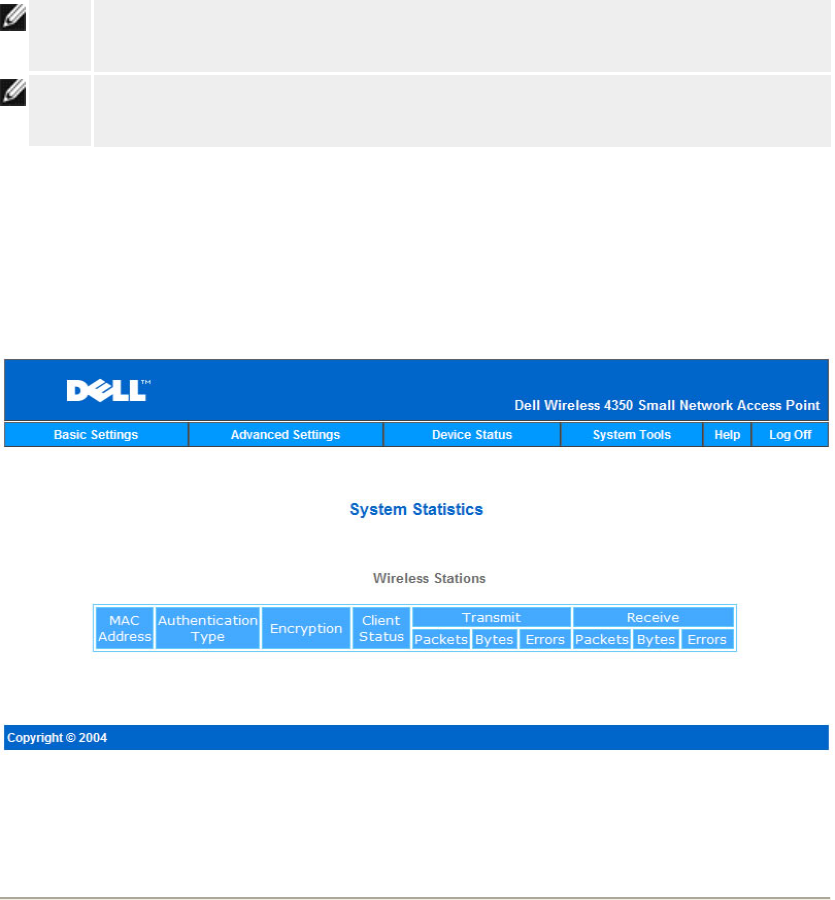
Export Current Settings File:
1. Click Export to save the current configurations settings into a file on the computer.
The default file name for the configuration settings file is dell4350conf.txt
Import New Settings File:
1. Click Browse to locate a previously saved configuration file to load into the access
point.
2. Click Import to load the configuration file. The access point will automatically restart
after loading the imported settings.
NOTE: The configuration settings files can only be used by a web browser utility on Dell
Wireless 4350 Small Network Access Points.
NOTE: Do not use the web browser utility to import configurations settings files created by
the windows-based Control Utility.
System Statistics
System Statistics
The System Statistics table displays diagnostic information on all the wireless stations
currently connected to the Dell Wireless 4350 Small Network Access Point.